Behringer
Ultramatch PRO SRC2496

Upsampling - is it
good or bad ?
Have I found the
best DAC in the World ? I can assure you - I am DAMN CLOSE !
february 2009
I must admit,
that I don't know digital technology well enough to dive
deep into explanations about upsampling.
So it must be
for the time being enough to say, that the SPDIF signal
is converted from 44,1 kHz to higher frequencies (96 kHz) and higher
bitrate (24) so
it "looks" like DVD or SACD signal. So DACs which are capable of
converting such high resolution signals - are working in different
conditions - at the upper limits of their capabilities.
I was offered to
test the funny machine - the famous Behringer
Ultramatch Pro- a box made for the pro audio industry , which can
convert and manipulate any digital
signal
to any other.
Among 100 other
functions - Behringer can simply upsample the straight
S/PDIF into 96kHz/24 Bit.
The box is
simply placed in series with the S/PDIF cable - between the
transport and the DAC.
I connected it
in my system between my Philips Fikus Transport and two
DACS which I had at hand - the lampized Buffalo Sabre32 and
Wolfson WM8742.
Normally - I
hate devices which add complexity and add manipulation to
the sound. I believe in less is better.
BUT
This device is
different, Unlike oversampling - which we already know
is VERY bad for music - upsampling may be sometimes VERY GOOD. It is
not the panacea, universal Hi-Fi cure, but in my system, very revealing
and transparent - I tell you as it was. YMMV.
I can tell you -
after hitting the UPSAMPLE button on the Behringer - I
was taken to heaven. The DAC strarted to behave like a magic box.
The normal
signal, the normal sound - was taken to another level.
Something
extraordinary happened. I have big problems putting it in
words, especially English.
Music becomes
smooth, liquid, magical. The same music which sounded
just great without Behringer - with the process of upsampling sends the
chill up my spine. Whhhooooa! Now this is another experience - this is
high end. I CAN'T POSSIBLY GO BACK TO NAKED DAC. The whole thing is
about the PLEASURE of listening. It increases much.
Now - the price
context - we are not talking 100 000 Euro like for
Goldmund heavy CD table. We are talking maximum 150 Euro, or even
less. I bought mine for 80 incl vat, brand new with warranty etc,.
Yes, for a mere
100 Eu extra - our transport - DAC combo can be
improved by a whole level.
I can not
guarantee that this will apply to all DACS - your mileage may
vary. But if the DAC is a 96 kHz/24Bit compatible - the
Behringer will be your best spent 100Eu ever.
I am keeping my
unit.
Or maybe - I2S -
withoutr Behringer will sound even better ? I must
check it.
Generally, the studio pro industry seems to have completely different
price point calculations than High End. Their product costs the cost of
parts and labour plus a margin.
Not "cost plus 10 000 Euro. " The built quality
is very good, parts are good, sound is great. Such a honest product
that my hats off.
Behringer Ultramatch Pro SRC2496
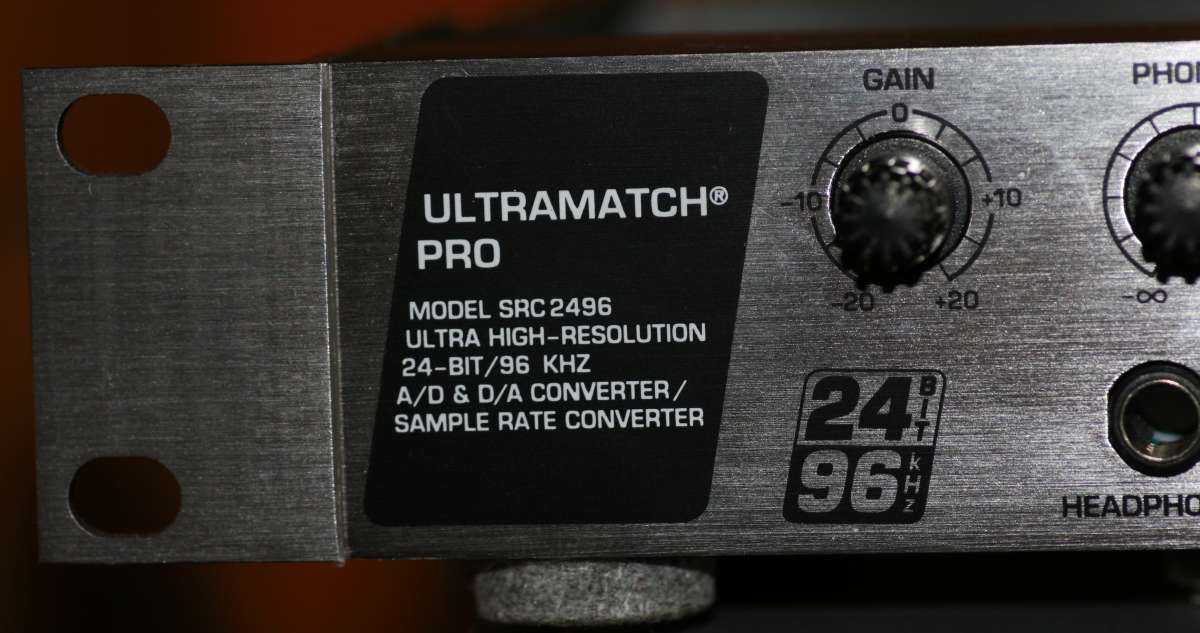
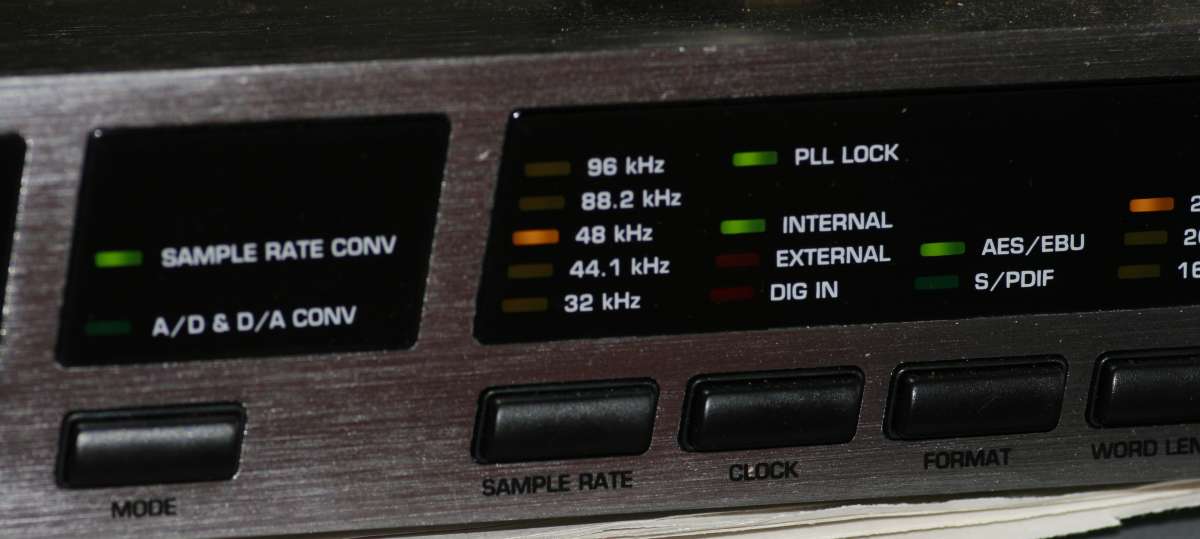
What I dont like is the amount of LEDs and options on the front - but
hey, it is a PRO equipment not home lifestyle. And if it plays well,
who gives a shit.
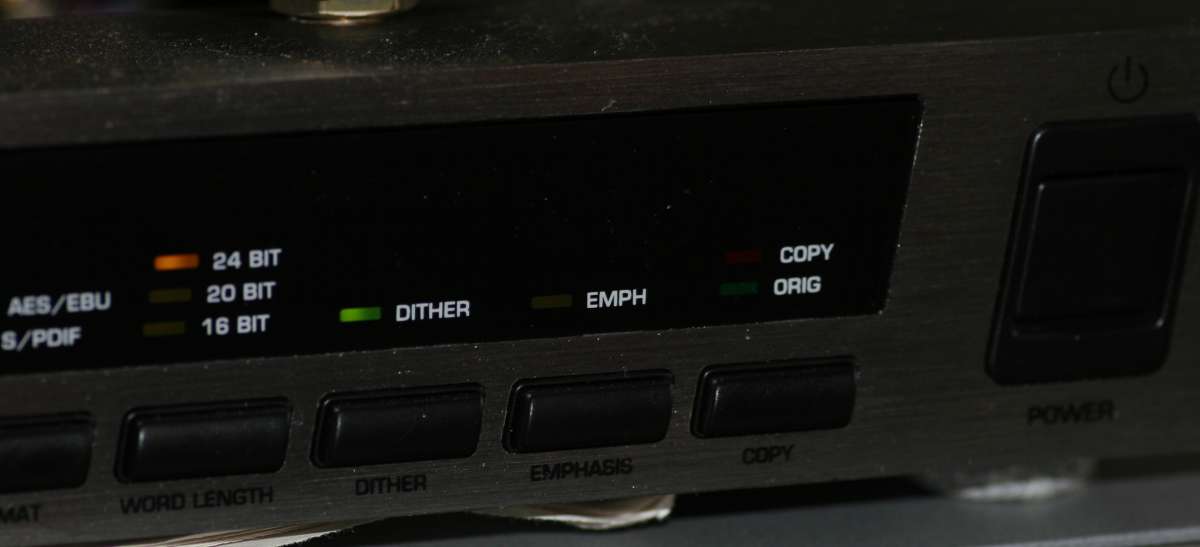
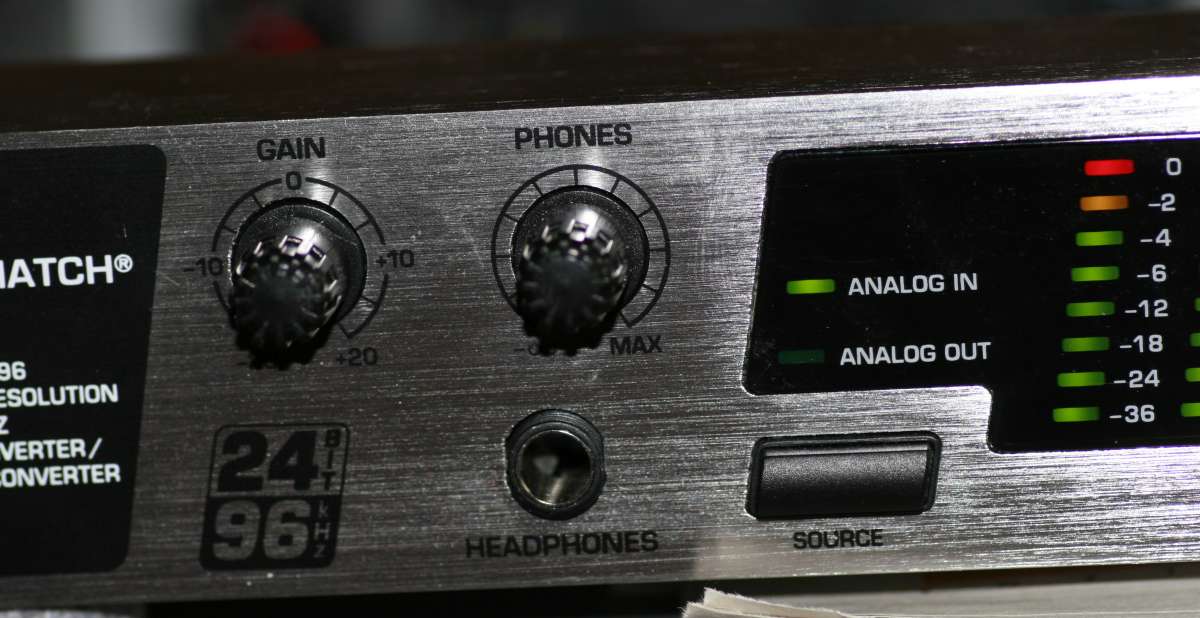
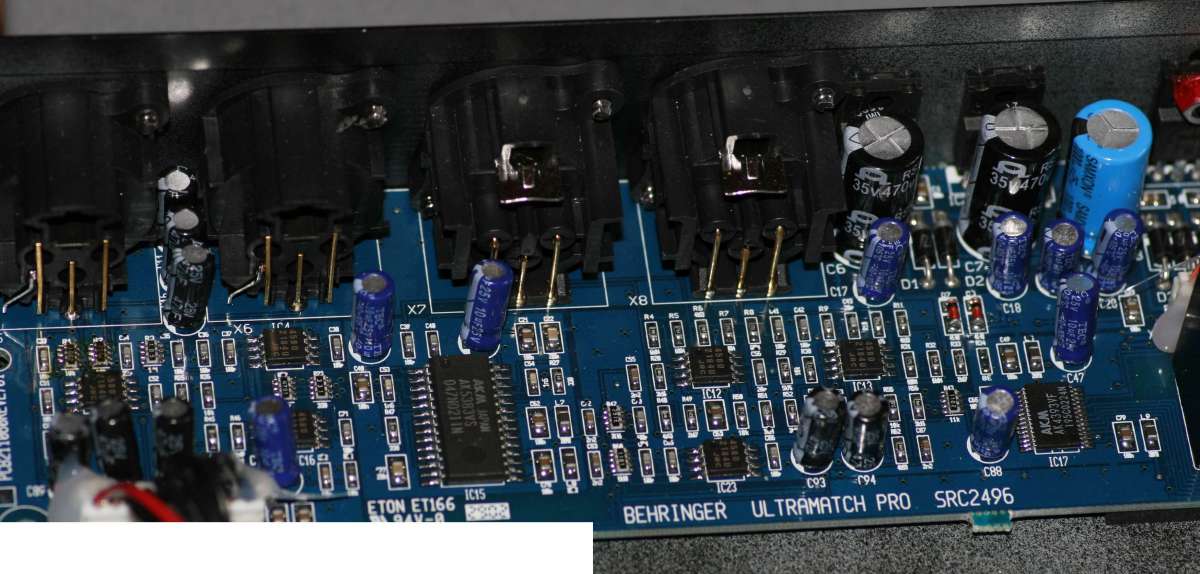
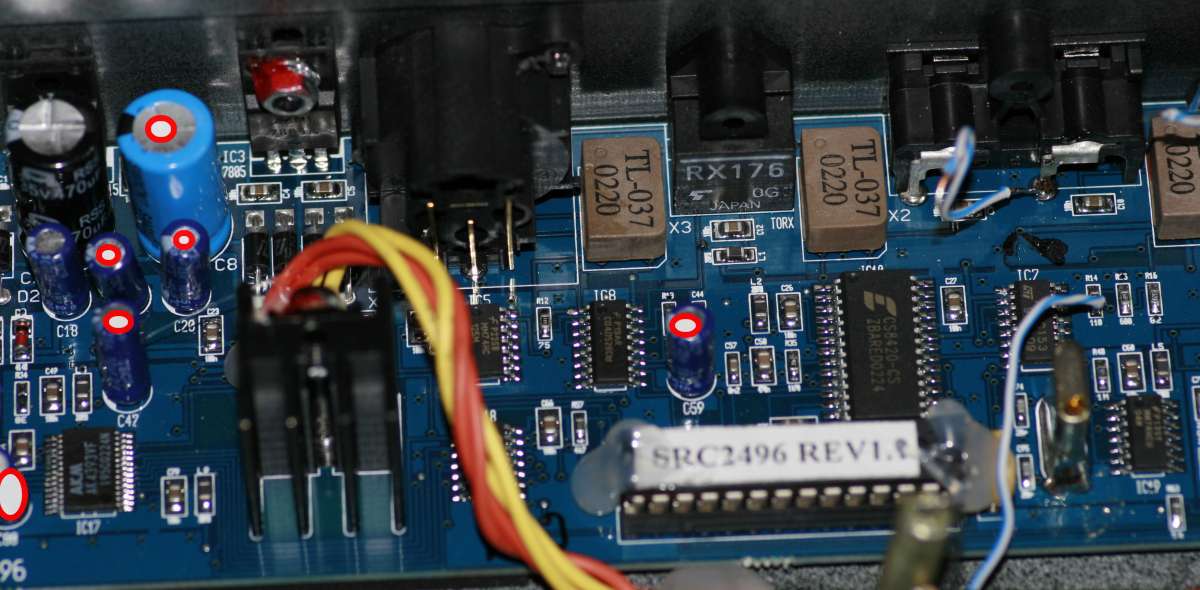
The red circles indicate the caps that can be replaced. Tantalum
10uF/10V are good for the small ones, but not for the big blue one .
Blackgates are good too.
Generally - dont use caps bigger than 100uF - and the big blue can be a
few thousand uF by minimum 16V.
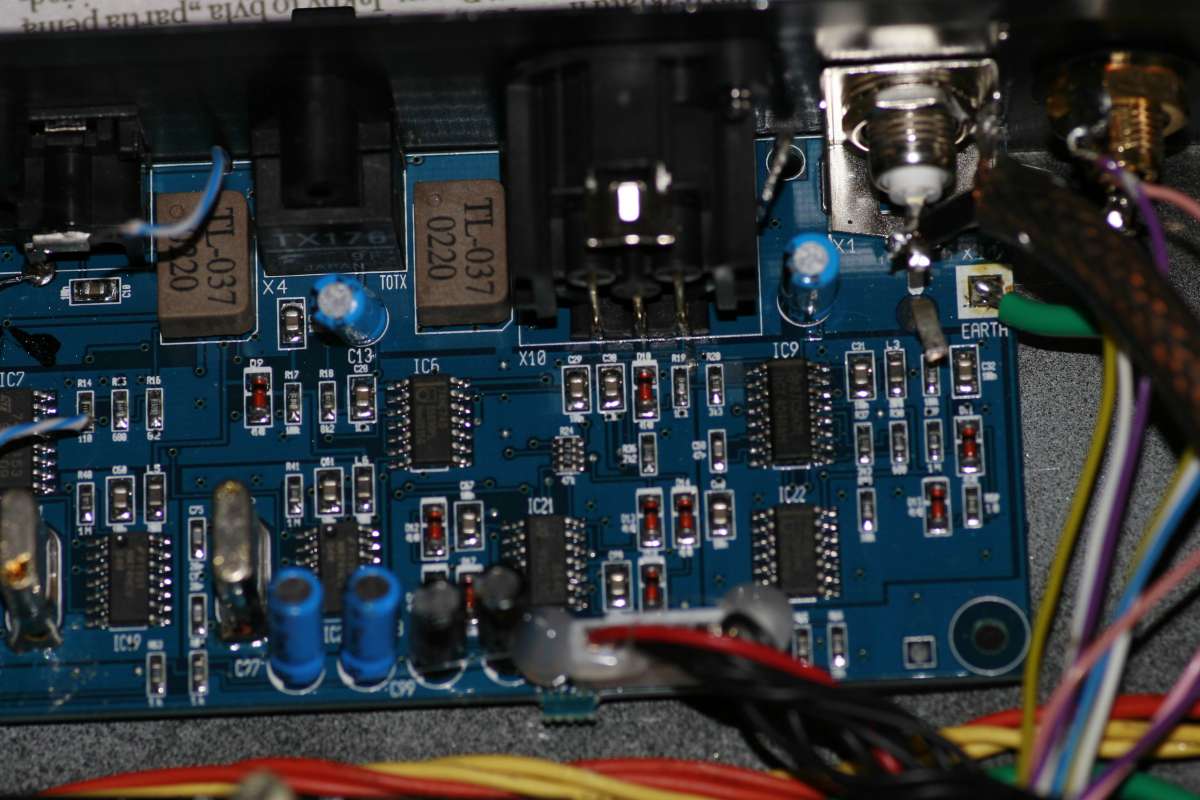
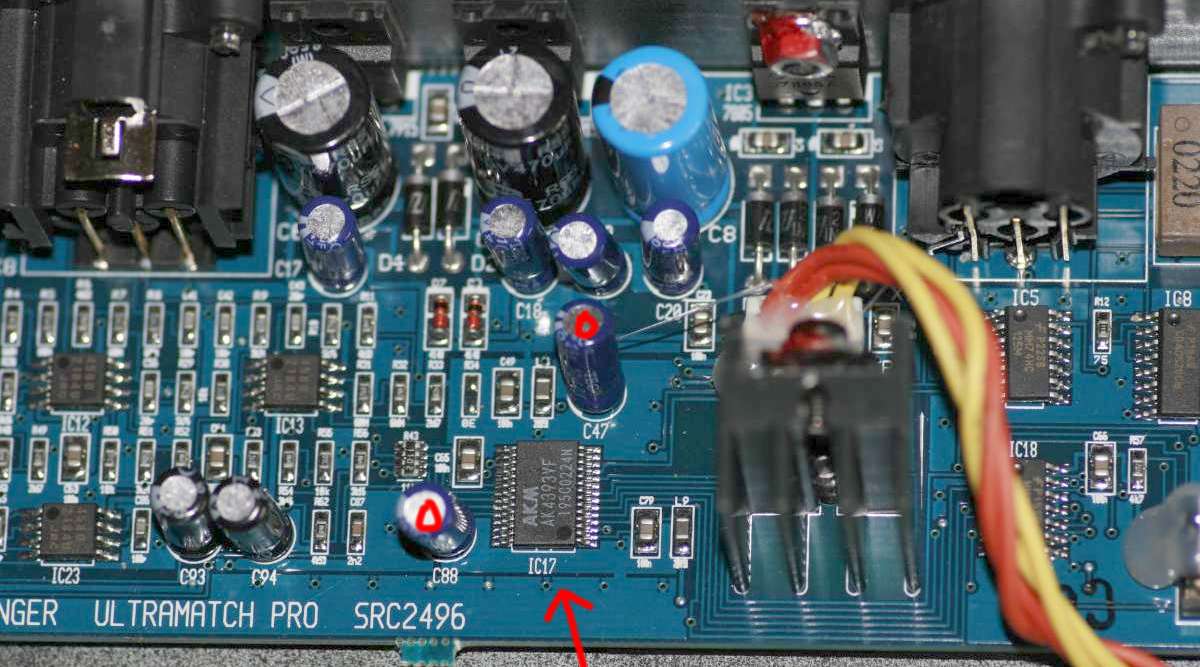
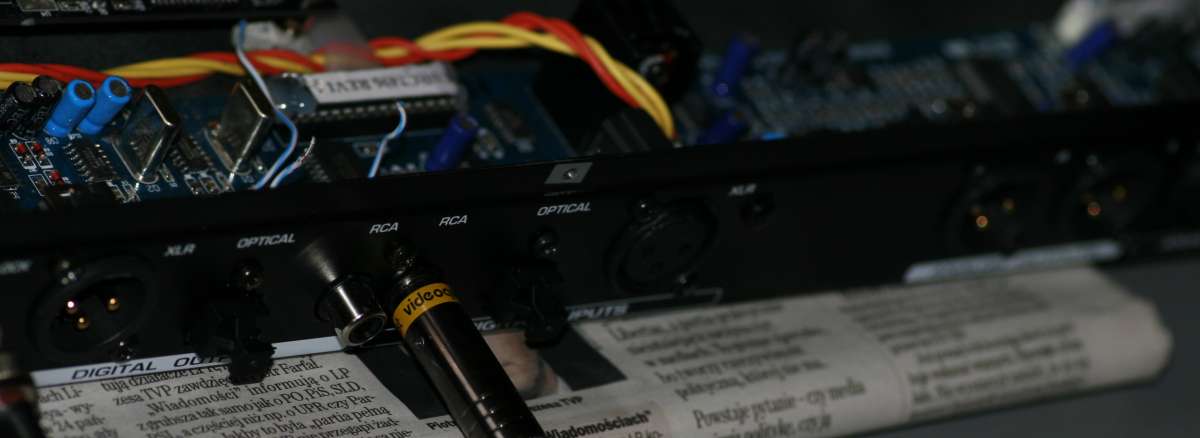
What else dos
behringer Ultramatch Pro does ?
Well,
I am really
impressed. Not only Ultramatch upsamples, not only it
accepts AES/EBU signals, Toslink, S/PDIF and outputs all and any of the
above. It also has a very good ADC converter for recording analog to
digital. It also has a built in DAC - a superb Japanese chip called AK
4393. You can simply add lampizator to this DAC and you have a high end
DAC with upsampling built in .
You could also
upgrade the cheap electrolytic caps to the oscon ,
blackgate or even SEPC Oscon level. So the sky is the limit on
Behringer.
I will
investigate it further and you make sure you buy one to
experiment.
The only
downside is the looks - it has visual design not from my
preferred style to put it mildly.
A month later.
I was sitting at
home on one sunday afternoon and suddenly an itch occurred, a fire in
my
fingers - to SOLDER SOMETHING. I did not feel like a long project - so
just for the hell of it I grabbed the soldering iron and I put 2 wires
from test box Lampizator to the Behringer Ultramatch Pro DAC chip -
abovementioned AKM AK4393.
(I swear this
SMD print is so f**g fine and thin and small that you better ask
your friendly eye surgeon to help you with soldering.
Anyway - one -
two - three - the behringer is lampized.
I have floated
the DAC outputs and soldered them directly to SRPP using Tesla Goldpin
E88CC and 200 Ohm resistors in cathodes.
I admit - I was
expecting good sound. And it is good. It is damn good. I have direct
comparison with the second Behringer working as upsampler only and
driving a hot rodded Lampucera with the mighty DAC CS4397 and I am
telling ya - The AKM DAC is a little bit better. Even BEFORE cap tuning
of Behringer.
AKM DAC (NOT
EVEN THEIR TOP MODEL) is equally good as ESS Sabre32 Reference
DAC, equally
good as Wolfson WM8742 , but the fact that it is DIRECTLY BUILT IN -
makes it a winner. The upsampling process applied directly from
Behringer on the dac has a clear edge over two unnecessary S/PDIF
processes - out of Behringer and into the Lampucera receiver chip. The
AKM omits all that and it sits right on the music.
To my ears, the
Lampized AKM is a DREAM COME TRUE: the quality is mind-blowing,
that's how good it is. We get (okay - an ugly) case with power cable,
switch, all power supplies, transformer. display LED, we
get all we need except lampizator.
This device with lampizator installed
- becomes my new reference DAC - but of course only with the upsampling
function active.

Above - one VERY good variant of Behringer without tubes. It uses
two sowter 9545E transformers instead. They are running from
balanced DAC direct outputs into SE secondary. The connection takes 5
minutes and the sowters cost 140 GBP per pair. Together for 200 GBP
including a new Behringer we get a stellar performer !
Recommended. On the sound quality scale between the stock opamp stage
and the lampizator stage this is 90 % at the lampizator's end.
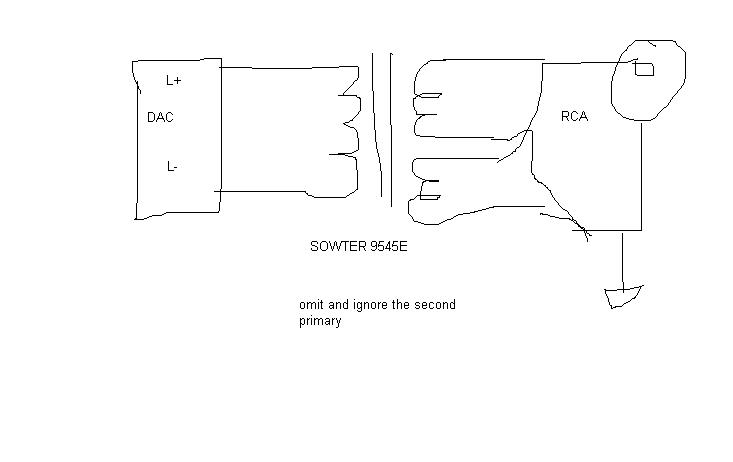
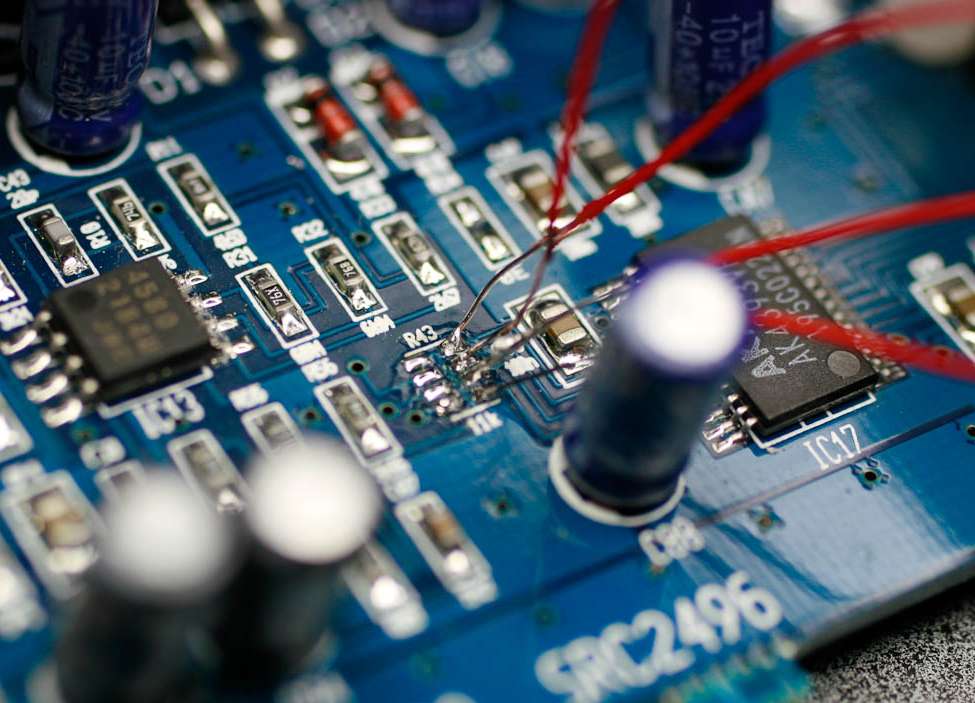
To steal the signal I removed completely the integrated quadrupled R43
resistor 11K. I simply applied on the quadruple resistor a big drop of
solder which heated it so much that it fell off.
Then I soldered AWG30 silver wires to the soldering spots on the DAC
side of those resistors now removed.
Counting from top of the photo these are R+, R-, L+ and L- voltage
outputs with very small DC offset. I measured only 0,15 V not 2,5 as
usual. In fact - I believe they can be connected to tube without
any caps in series - just wired directly to tube grids.
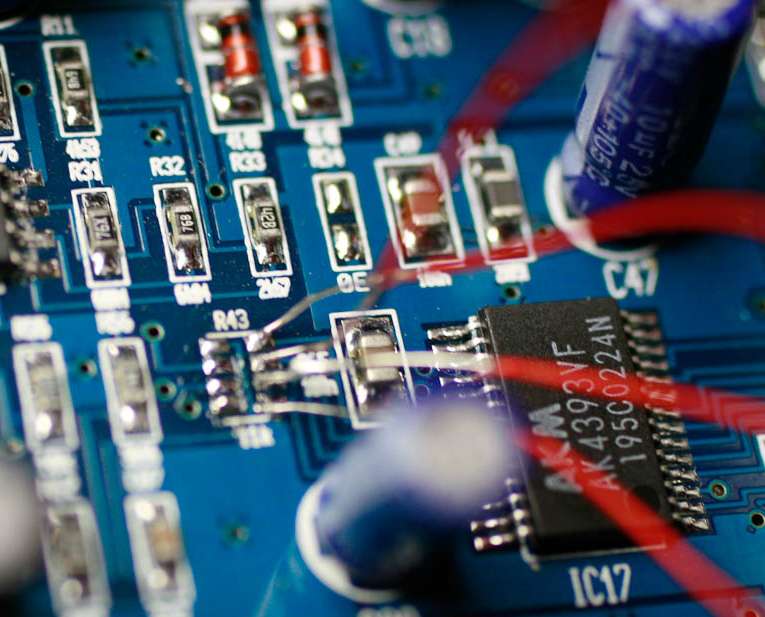
This system does not require any filter in analog domain.
I wire it naked sauté to the tubes.
If you use single ended solution with one phase - use 1st and 3rd
point, or - 2nd and 4th.
Better way is to use them BOTH phases and all 4 signals.
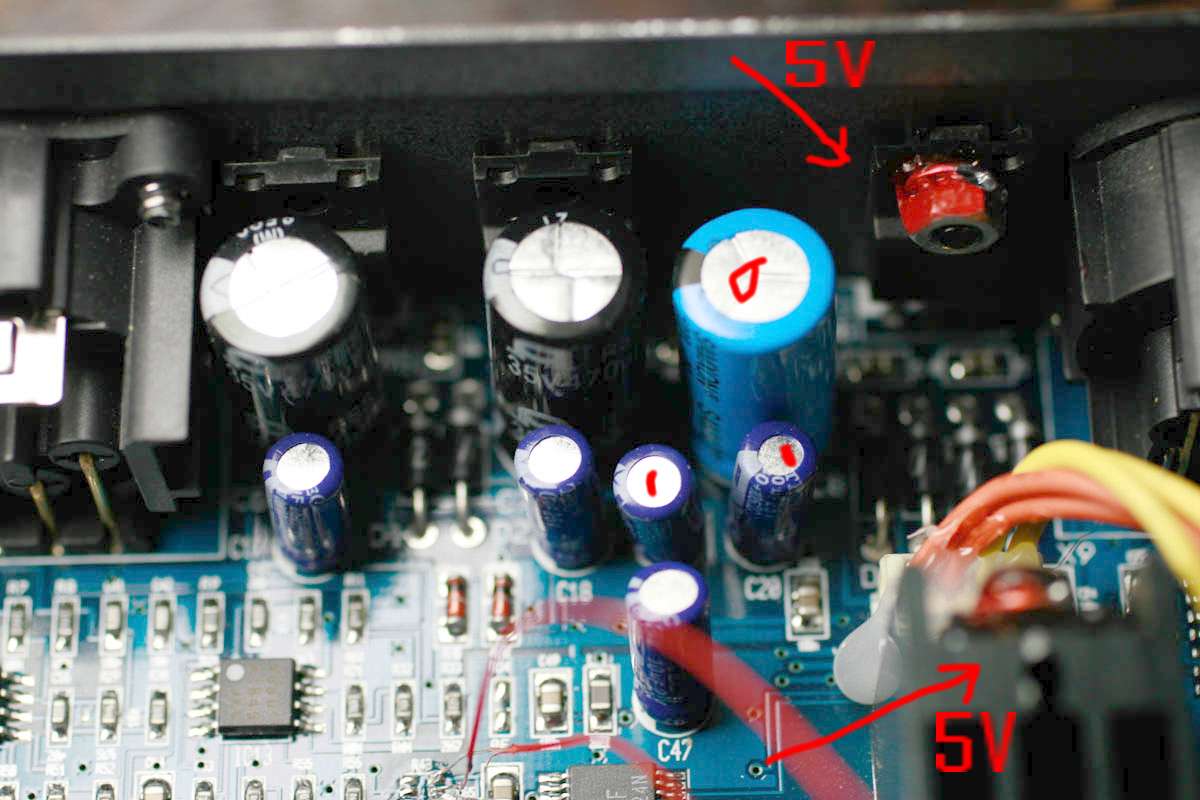
This product has 4 voltage regulators: two for opamps - 15 V and -15V -
these regulators are on the back wall, left of the one marked 5V above.
Their role is for output opamps and headphones. I did not need that so
I have cut off their respective AC power - the yellow pair from
transformer.
Other than that - there are two 5V regulators. Main one is on the back
wall with big screw. This one supplies the DAC and some other parts. In
all, 5 caps buzzed to confirm connection to this regulator's output.
The biggest blue cap above on the photo with red circle mark is BEFORE
the 5V regulator - it is the main raw supply. You need a 16 V minimum
rating for this cap, and a minimum of 1000 uF. I used 3300 uF Nichicon.
I experimented with the remaining 5 small electrolytes, and the small
BG HX HQ 22 uF were best for me. I did not like oscons there - can't
say why.
Later I decided, that since I am adding the new transformer anyway - I
may replace the stock miniature transformer (the small EI below)
The stock trafo has two secondaries:
10 V for the 5V DC regulators (our good supply) and 18 V for the
opamps. Cutting the opamps supply - yellow pair - does not affect the
digital functioning of the Behringer but the trafo has easier work when
the opamps are killed.
So you can cut the yellow and keep the orange wires.
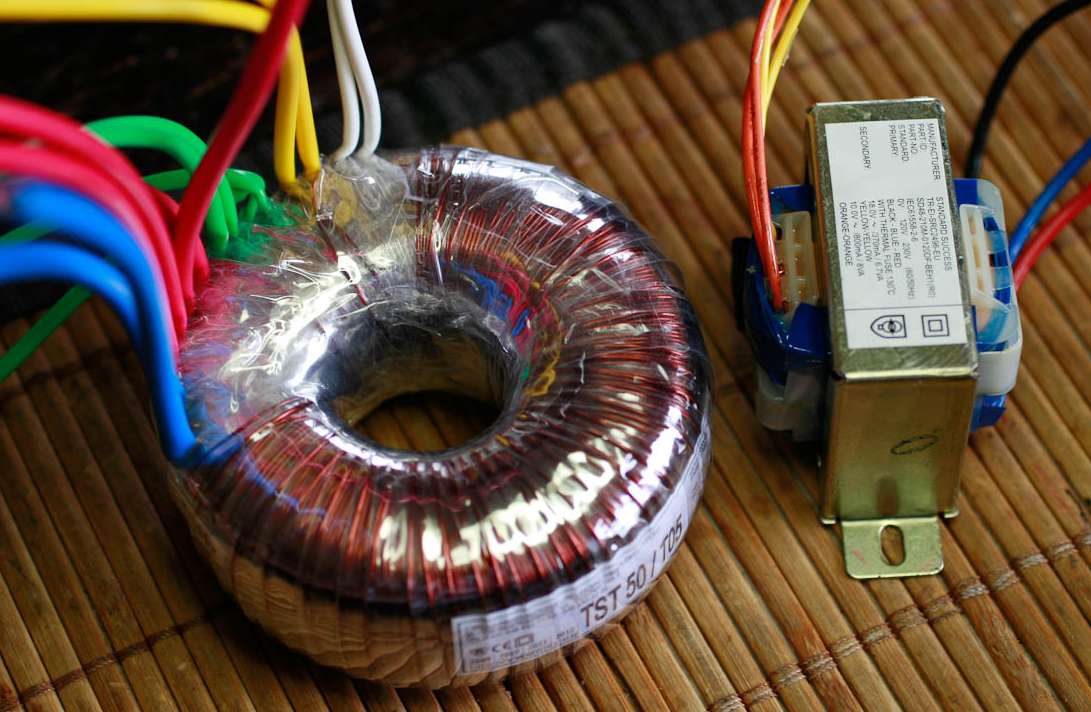
The big trafo is my new Lampizator transformer with 5 V (for
rectifier tube heating) 2 x 6,3 V, 2 x 12,6 V and 2 x 230 V ac You can
do any tube circuit imaginable with it.
I decided to use the 1A secondary 6,3 V AC for the Behringer in place
of the stock trafo, and then - build the lampizator.
6,3V rectified gives 9 V DC, ideal for 5V regulators.
BUT WRONG WAY !
This did not sound good at all.
Then I used 12 V secondary (18 V rectified) and it sounded much better
but the regulators overheat.
So I went back to the stock trafo - the 10 V AC output (15 V rectified)
and it is just perfect. Without the opamp load - with yellow wires cut
- the stock transformer is really very good.
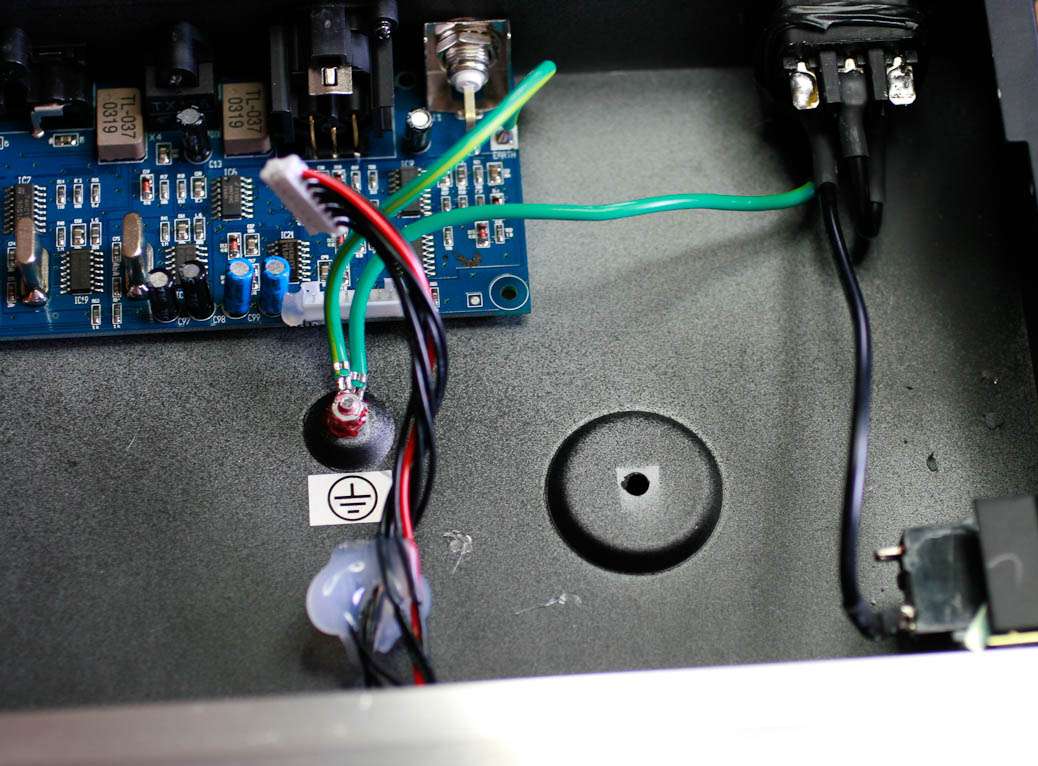
As you see above there is a provision for the star ground point as well
as toroid transformer mounting nest. Just perfect.
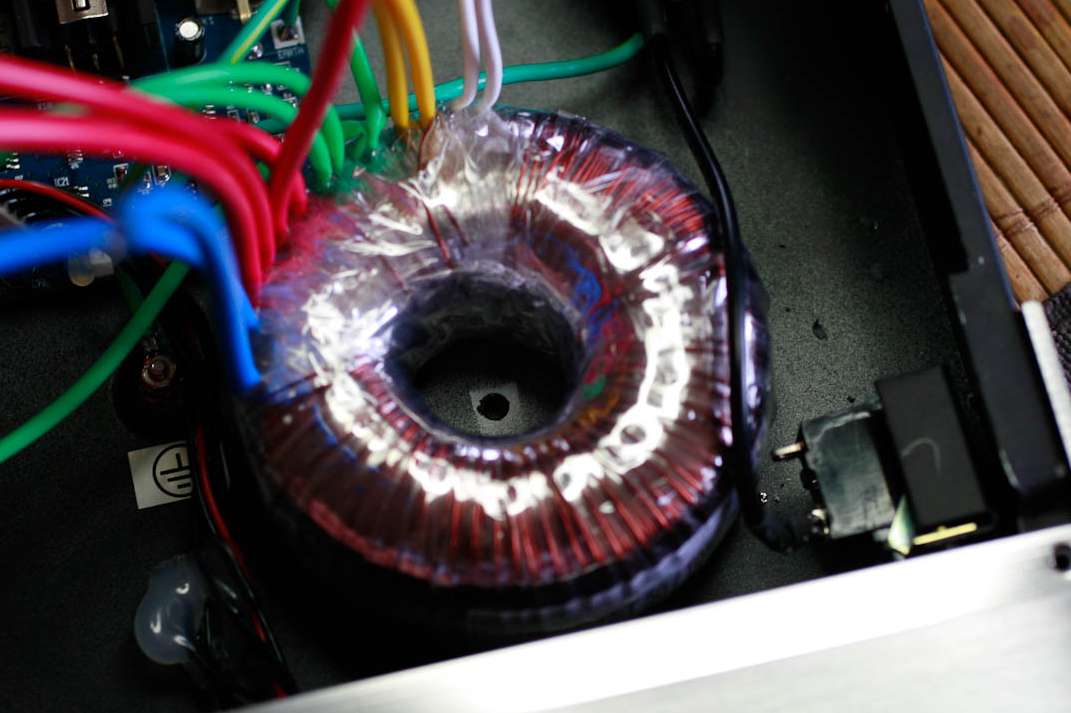
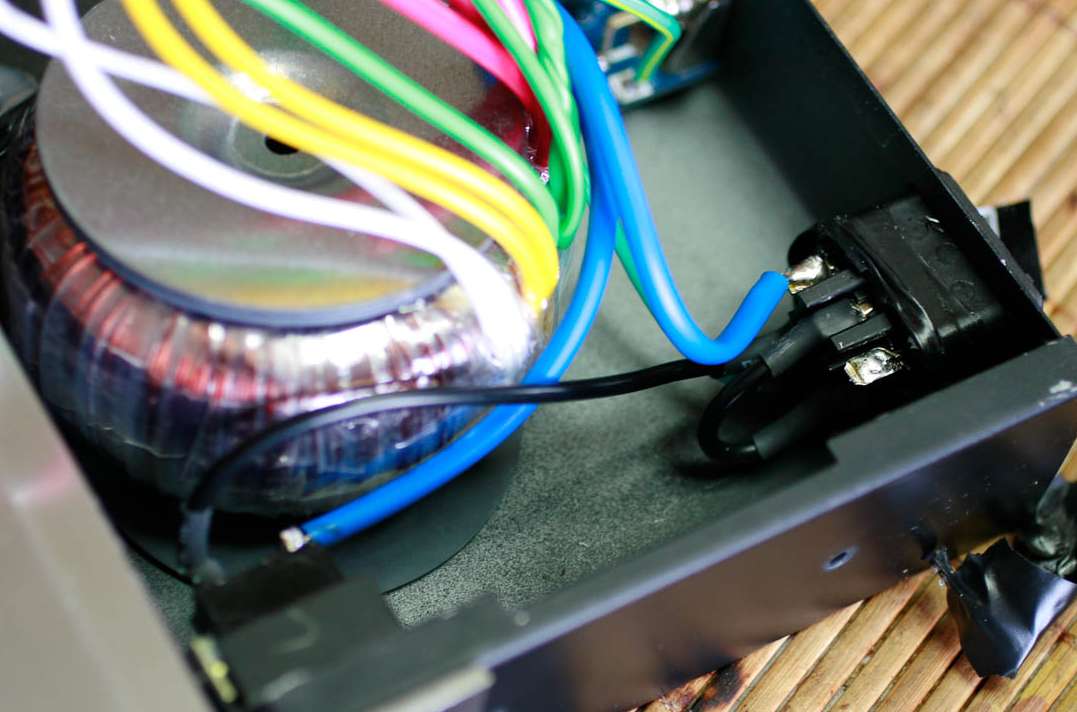
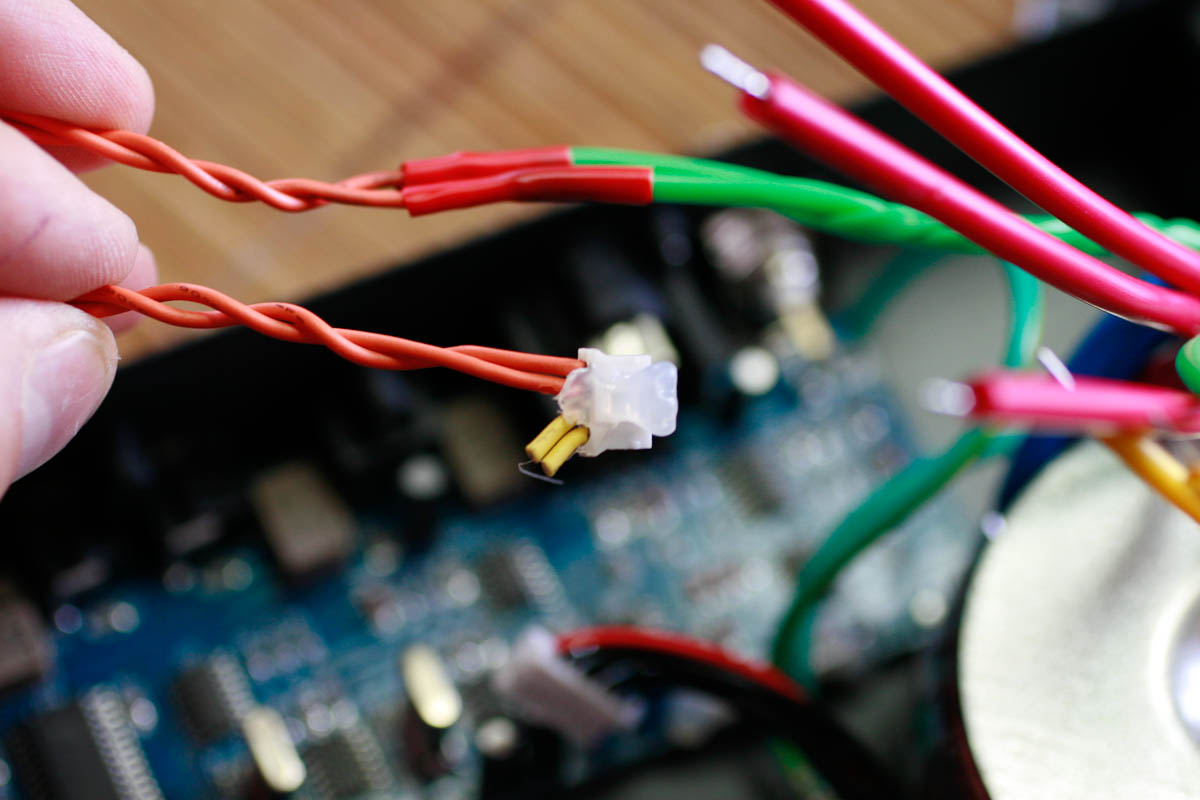

If you are one of those persons who need exact recipe - use 330 Ohm Rk,
200 VDC Ua, 250 K grid resistor, 2,2 uF input caps MKP by 160V or more
going to grids, but the other phase of signal must have bigger cap - 10
uF is an absolute minimum. I used 22 uF Tantalums, plus side towards
cathodes. .
All
resistors 1/4 W metalized 1% type.
Tubes - any choice from the above list. My best pick is e801cc from
Siemens or 6H6P Russian.
Below in the schematics of power supply use 20 or 40 mH choke by 20 mA
or more.
Here comes my cave wall painting power supply schematics:

OK , OK, I AM NOT GOOD AT DRAWING !!!
Download schematics of Behringer HERE (2 MB)
BEHRINGER PROPERLY LAMPIZED
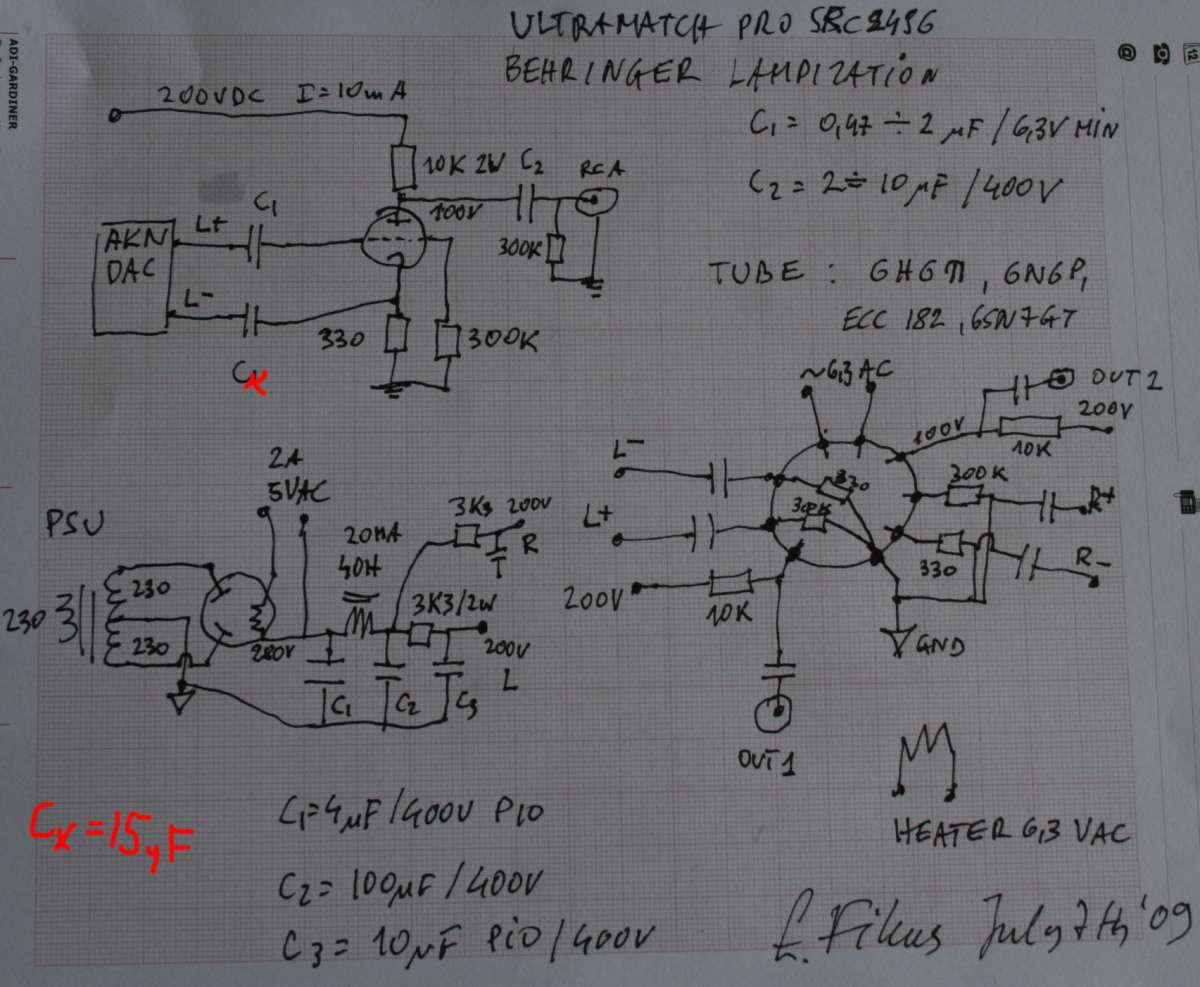
The above is a one tube variation of the previous scheme. This is my
actual reference in real life. Very elegant and pure design.
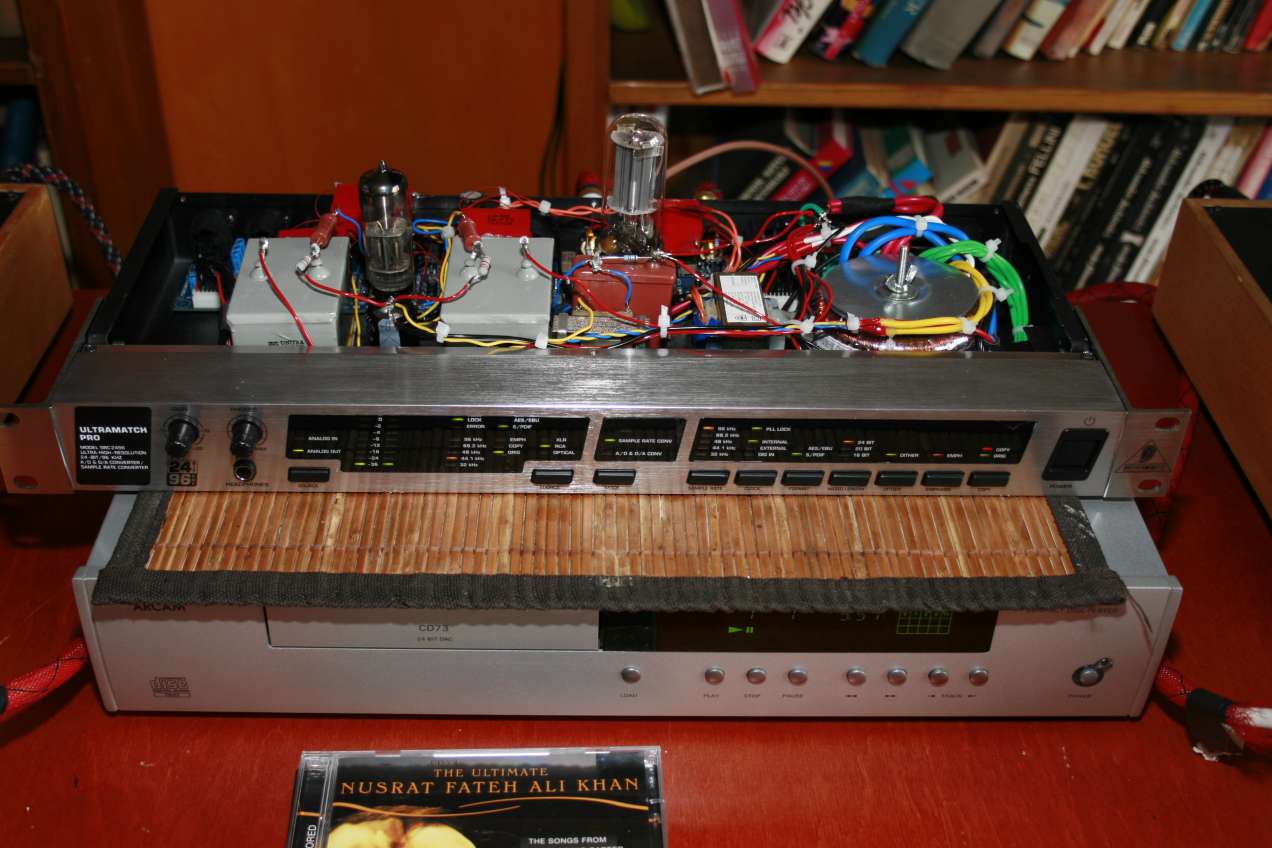

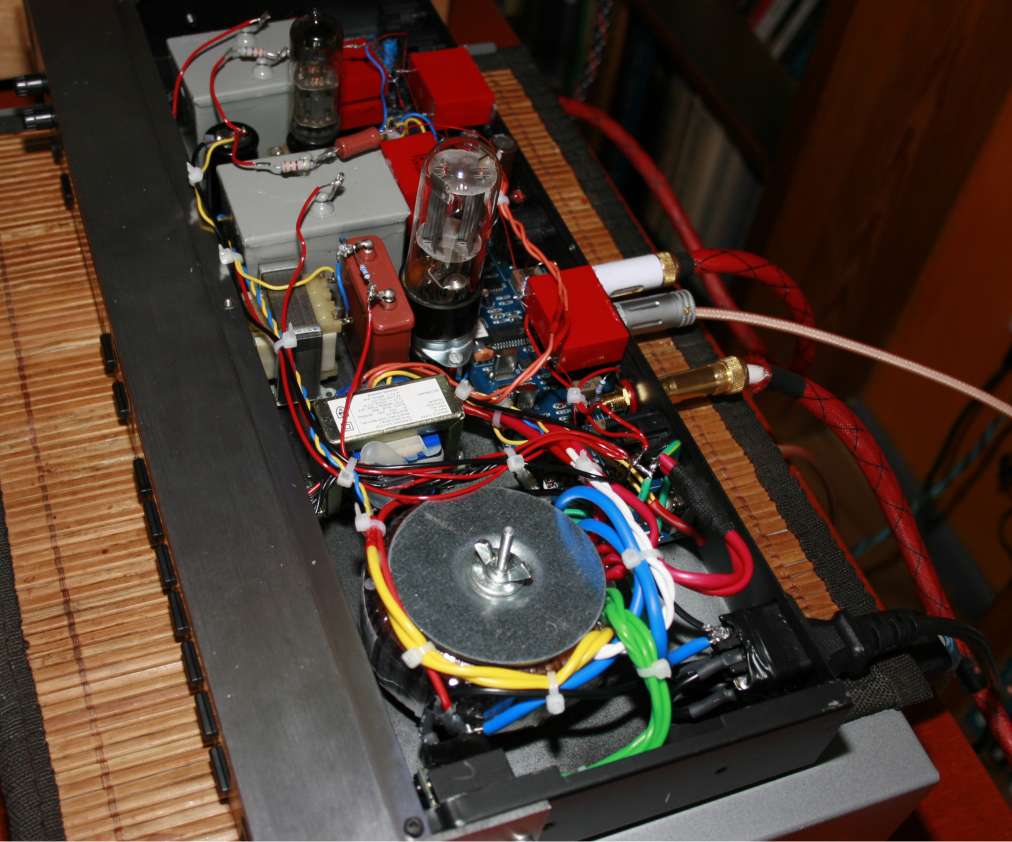
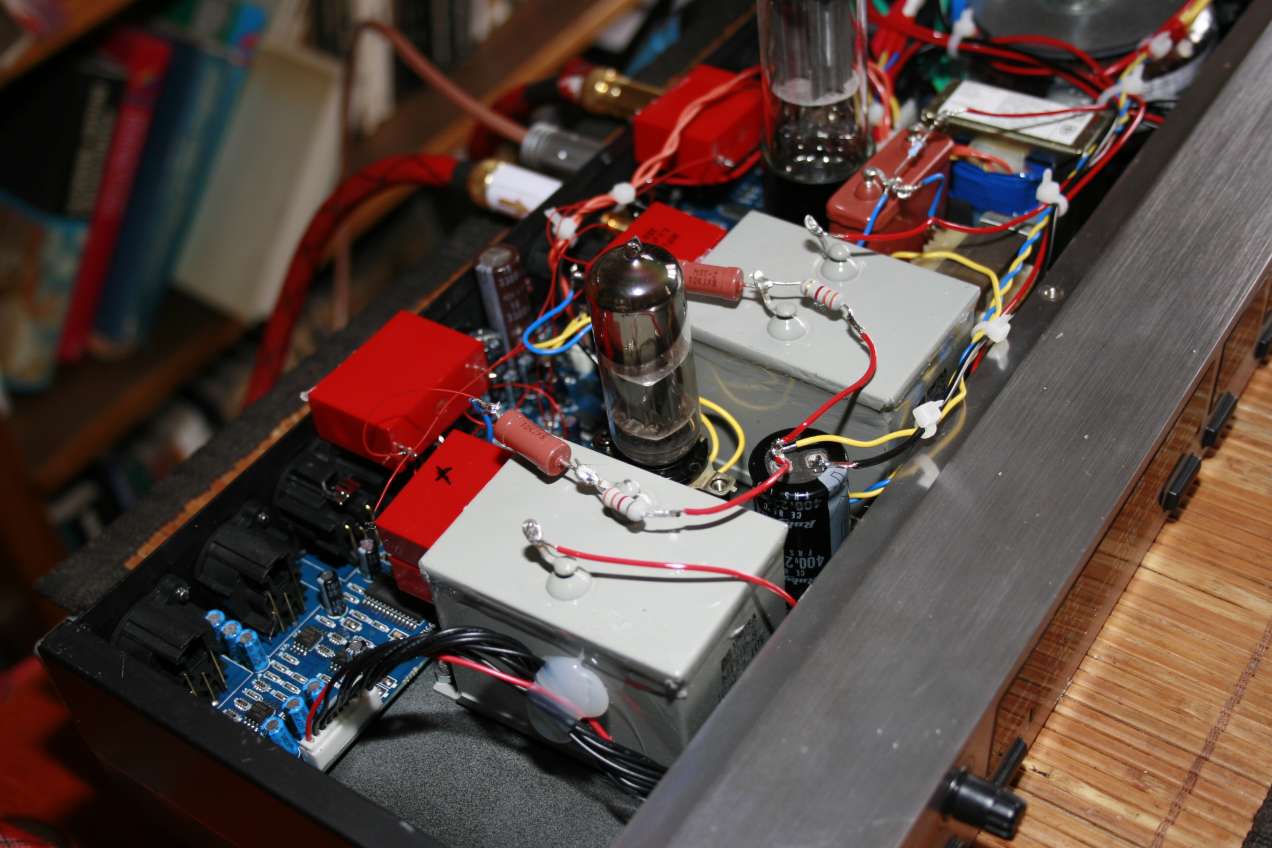
===========================
July 18 2009
I want to get better results - my analog stage is almost perfect. There
is not much more one can do.
Of course everybody is more than welcome to try and do better. I am not
claiming to know anything about tubes, I just have fun trying various
solutions.
To better the above design one can:
1. Make dual mono construction with two power supplies.
2. Use exotic parts. I tried to use electrolyteless
design with all PIO in power supplies (first - 4 uF as maximum allowed
by tube datasheet for the diodes, and then - two caps of 10 uF after
the choke. It is very very clean design and sound.
3. Make it fully balanced by using one triode per phase per channel.
In that case - the minus signal is used the same as plus (to the grid)
in separate triode. (second triode of same tube).
Now I am going to upgrade the Behringer PCB again.
I already upgraded the power supply caps to a mix of tantalums and
oscons.
The output analog stage can be upgraded (opamp power supply and
coupling caps) and it will give very good results. But I opted for
lampization instead, because no matter how you tweak the opamps - they
will not even come close to tubes. The energy and slam of tubes cant
be matched. It is like comparing the traffic light acceleration of a
car and sport motorcycle.
Anyway - my next step is the DIGITAL INPUT SECTION
Thanks to my audio buddies relentlessly searching for the Holy Grail, I
already got some tips.
1. The digital signal comes in via a digital transformer.
Its role is a mysterious one. It sits there God Knows What For. I
know that a telecom cable buried under a desert needs a transformer to
avoid the ground potential differences and to protect from damage. (by
the way - the modern day S/PDIF receivers are offspring's of the
broadly used long distance format called RS422).
But since we are not sending our signal over a distance, under the
desert, and by the cable that's one mile long - we don't need the
transformer at all.
Our receiver is a simple device - it sits there waiting for the zero to
become one or vice versa. A simple gate is triggered by the square wave
going up or down. The gate could not CARE LESS whether the signal
arrived by the cable of 75 Ohms, by a coax, twisted pair, lamp cord or
else. The transformer can not add any value added to the zero becoming
a ONE. So in DAC-Transport connections we can completely ignore the
whole "75 Ohms " hysteria.
Why inside players the same digital signal can travel over one metre of
thin trace without any transformer and any 75 Ohm termination ? And in
outside cable - all of the sudden - it MUST ???
I know that I am alone here, and every audio guru, specialist,
salesman, critic or even engineer will tell you that the S/PDIF
transmission MUST be terminated at both ends with 75 Ohms and the plugs
must be special and the cable must be of characteristic impedance 75
Ohms. However NOBODY EVER demonstrated that it matters to the sound, or
even to the oscilloscope or the "happiness" of the chips involved.
Of course - the ONLY proper way of sending a fast signal far away is to
use not coax but twisted pair and balanced signal. THEN WE DO need the
transformer at each end to de-symmetrize it. Or in case of receivers -
like CS84XX - they have already built in symmetrical inputs.
After removing the transformer, we can connect our good new RCA
directly to the output positive leg of that transformer.
This brings audible effect comparable to a MAJOR cable swap or tube
upgrade from chinese to NOS.
We can stop there.
For the open minded, Mister Andy - the Shigaraki guru - proposes to go
further and remove the first chip on the input - the analog
multiplexer. It is needed only for the people working with multiple
digital inputs at the same time. THANK YOU ANDY for being so restless.
We small mortals just need the Behringer to play one input - S/PDIF
from our transport.
Actually I may be using the second input for the Squeezebox..
What Andy did is simple: he found the input leg of the upsampler chip
CS8420 which has the S/PDIF readily available as input - and he wired
that directly via a series 100 nF cap to the RCA input. Bypassing the
MUX chip completely. Connect to the POSITIVE input of the chip, and
wire the RCA ground to the digital ground point nearest to the
Upsampler chip.
HERE IS THE DATASHEET OF THE MUX CHIP
My advice is verified by first hand experience. It is excellent upgrade
!!!
Just look:
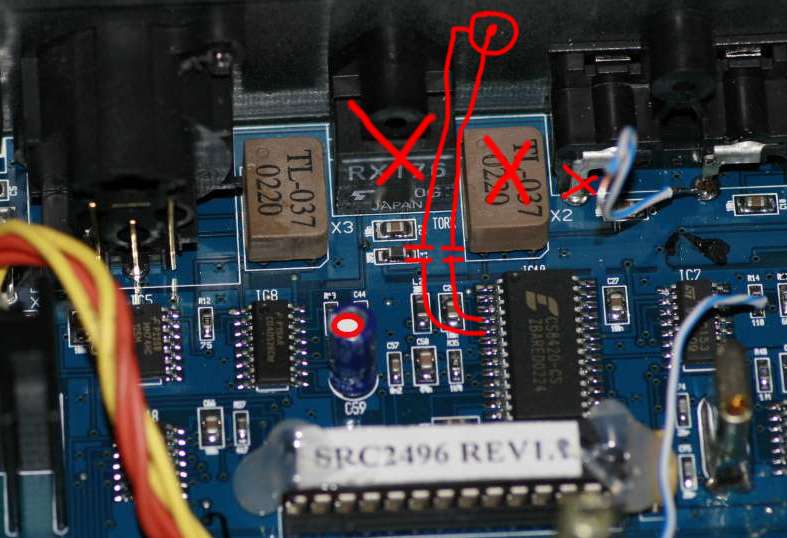
With a magnifying glass or just very young eyes you can solder a thin
thin wire to legs 4 and 5 of the receiver - upsampler DAC.
Leg 4 gets plus of S/PDIF and leg 5 the insulated minus (not touching
chassis).
The minus of RCA should be grounded.
The RCA can have 75 Ohms across or not
The caps from RCA to Receiver are in my case 100 nF MKP, but any value
between 10 nF to 1 uF will do. Ceramic 10 n is a good choice, like
styroflex, mica, etc. Just no PIO.
While we are at it we can remove also the toslink receiver. It wont be
needed anymore.
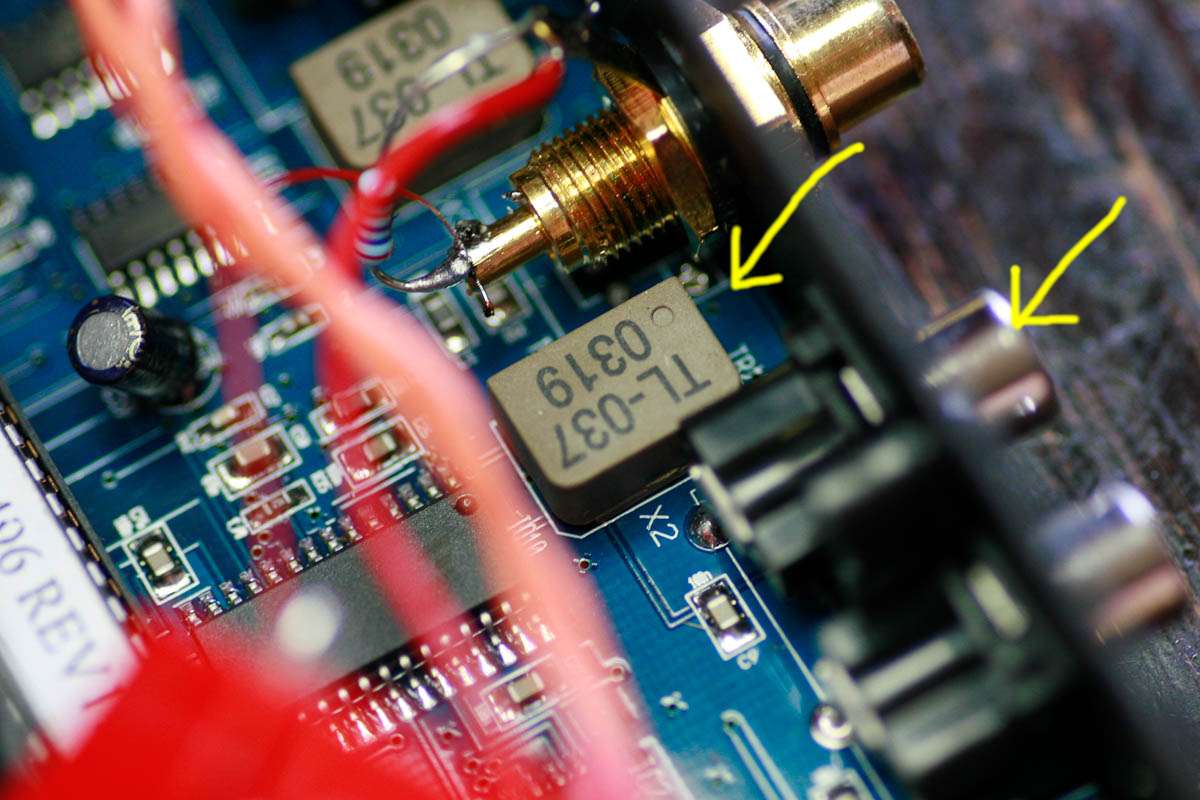
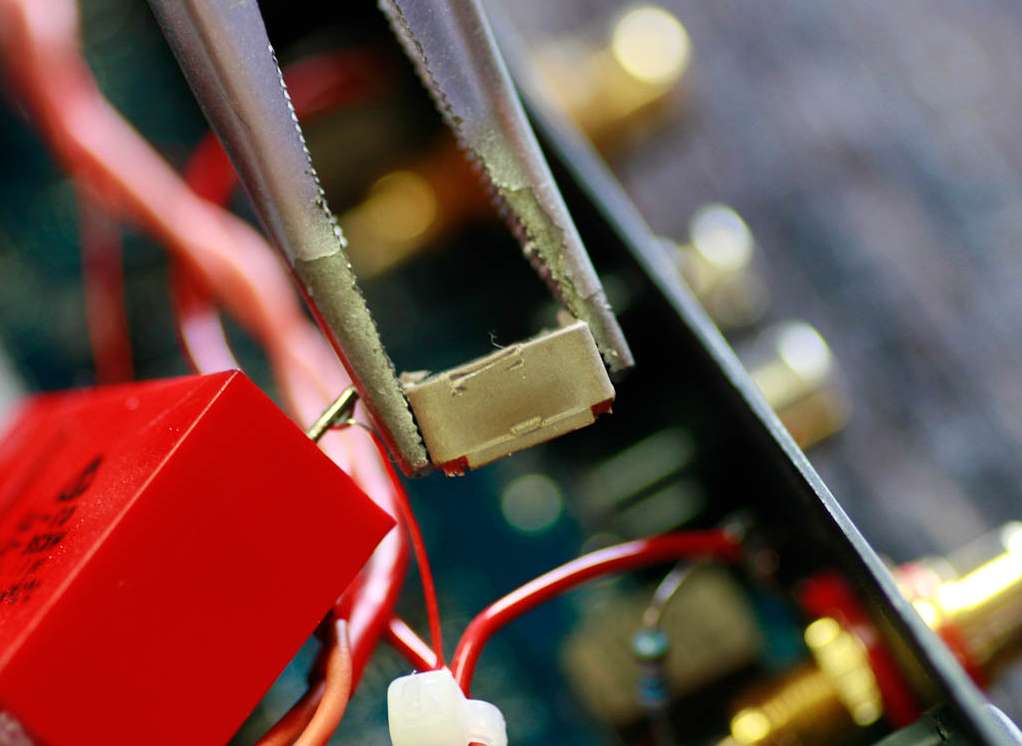
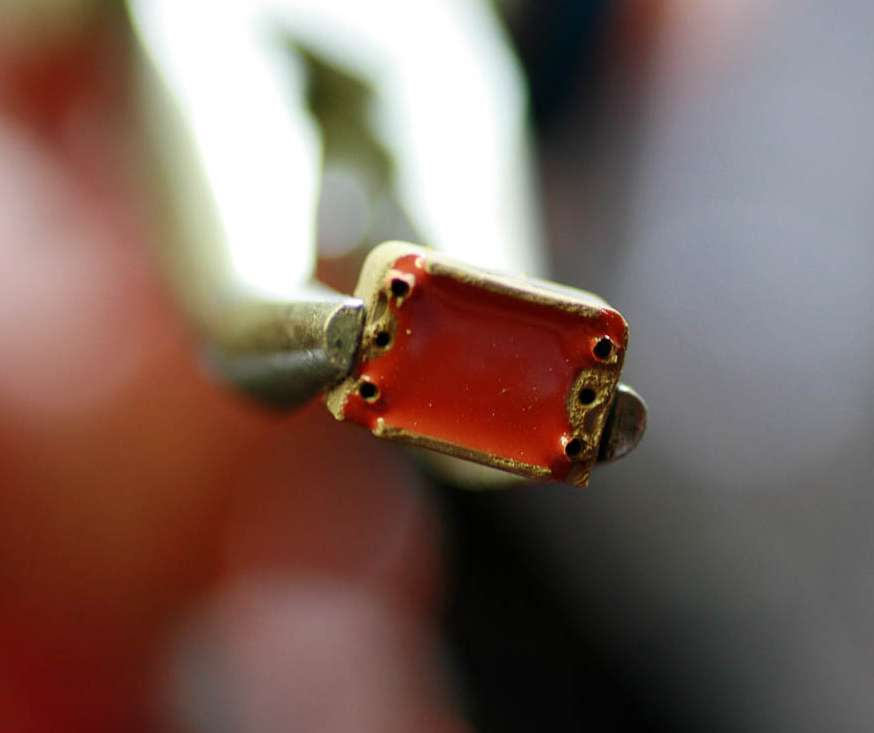

============================
We have no more low hanging fruits here. Going further is advanced
tweaking and in fact - not so important anymore.
We could:
1. Upgrade the upsampler chip to the newer, better model from CS
2. Change the AKM dac for the latest and best AK4396
3. Add two regulators for 5V to supply the upsampler chip CS8420
- one for digital - pin 23, one for analog - pin 6 . To do this we need
AC of 6-9V, rectify it to circa 8-10 V DC by diode bridge, then go to a
cap, like 3300 uF by 16 V DC. After the cap - put two regulators 7805
with left legs to the capacitor plus, middle legs to ground (cap minus)
and both right legs separated are outputs. At the outputs we put a
tantalum cap - like 20 or more uF by 6,3 V or more. We can of course
use any cap there - low esr, oscon or blackgate. Or simply a 4uF MKP or
something.
We will get two separate regulated supplies of 5VDC of high
quality which we can then feed to the chip inputs of power (after
floating them).
The two regulators do not need heat sinks.
FIND THE CS8420 DATASHEET HERE .
SOoooooo dear folks - we can take pliers and remove that bloody brown
transformer like a rotten tooth. Just make sure - you pull the correct
one.
==================
2 weeks later
The modded behringer was put to test with the Audionote champs: DAC4 ad
DAC2. Both have huge investments in blackgates inside, better tubes,
PIO caps etc.
DAC2 has the good old BB PCM63 and DAC4 has AD1865.
Behringer was for the first time an equal fighter. Even with the 17 000
Euro for DAC4 (plus 1000 Eu for blackgates and upgrades of
the A-Note) the
Behringer
sound was in my opinion more interesting, with wealth of details
presented in a very natural fashion. Behringer was drawing me into the
music. Audionote DAC4 had to fight very hard to match that.
After 2 hours - the scale started tipping on the Audio-Note side
because
of long warm-up of Blackgates. But the fact that such battle was almost
equal - is phenomenal success. Behringer is a real mature champion. In
my case - the cost did not exceed 200 Euro. Even without my cheap
buying price and with somewhat more realistic lampization price - the
total cost should not exceed 800 Eu. Wow !
Concerning AN DAC2 SE - the battle (in completely different system) was
also interesting. In that system I preferred AN DAC2 because of
its super natural "jazzy atmosphere" but on detail, space and rhythm -
AN had no chance. So it was down to a personal taste thing.
My friend ANDY has made two more discoveries:
1. You can remove the entire front panel and use the PCB alone. The
last settings by buttons are memorized in non volatile memory - the
settings remain even after power is down for the night. So we can put
the pre-set PCB in a new beautiful box.
Andy went even further - he cut the pcb on the line just left of the
DAC (analog stage, Analog output, input, ADC) and the DAC still works.
Don't forget - we already removed the yellow wire power, the
input transformer, the input multiplexer chip and many more.
JUST LOOK:
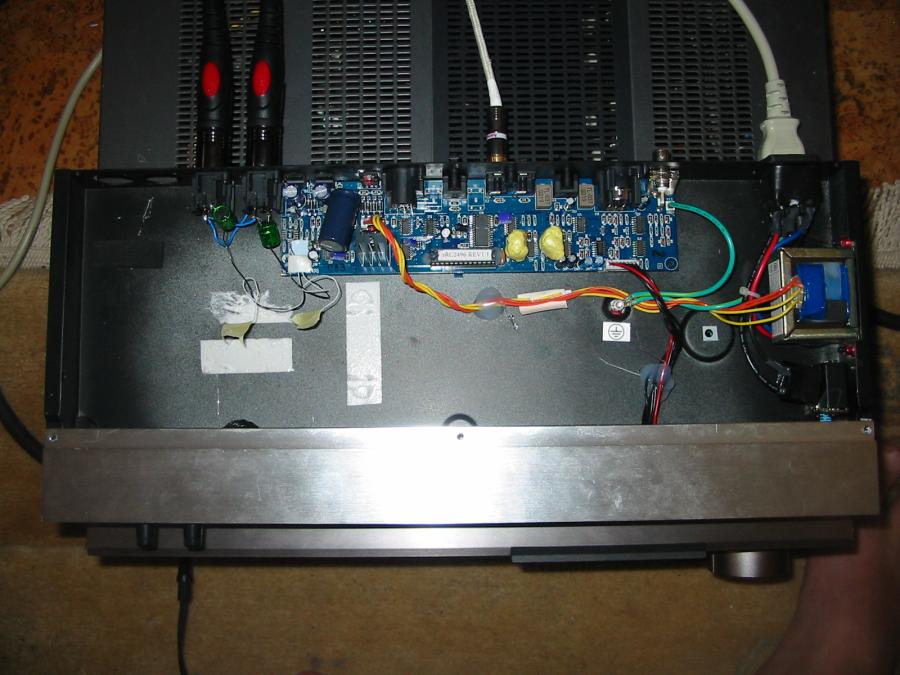
Here is also another product from Behringer worth mentioning - Lampizator version of Ultracurve
ONE YEAR LATER
I have an audiophile friend who borrowed my Behringer and he was blown
away and he sasid it is the best CD sound he ever heard and he heard a
lot.
So thats how an idea of a commercial production at Service was born.
I designed the new Behringer machine and Waldemar built his first DAC
from sctratch (what a rhyme !)
My design was to make use of the Ultramatch with the best of everything
we can come up with.
Tadadada drums rolling - here comes the world first Lampized Boxed
Ultramatch on Steroids. A monster of DACS.
Without a need to skip to the verdict here it is: the sound of this
monster is the best I ever heard from CD period. It beats the Audionote
4 and the Buffalo and the Wolfsons and the Satch - it beats them
all. Such ENORMOUS power, slamm, resolution, not even the
electron microscope but a whole goddamn HUBBLE telescope into the
musical event. This experiments almost redefines my whole thinking
about whats possible with digital.
I drove it by my squeezebox (untouched virgin one) and the result
floored me.
Enough bullshit - here is what I did (by the good hands of Valdemar)
I used a large box because there is NEVER enough space.
I cut away the empty parts of the Behringer's front panel (I mean the
alu profile) so the shorter "version" fits inside
I upgraded all 5V carrying caps on the main PCB with Oscons
(mandatory).
I bypassed all circuitry of the digital input, transformer and selector
MUX and I wired digital in - straight to the chip input leg via
just one series cap 10 nF - as described above.
I connected the AK4393 chip outputs to the tube grids via small 10 uF/
6V oscons in series.
Opposite phase of DAC output is left unused.
I designed a VERY oversized and overspecified power supply for the
anodes: with 50 VA core, CLCLC filter, two 40H chokes, one (first) pio
cap 1 uF / 600 V followed by a 470 uF rubycon and then the
GIGANTIC vintage siemens 1500 uF / 385 V .
The tubes are e88cc philips goldpin SQ series in SRPP config and
300 Ohm cathodes.
The lower cathode resistor is bypassed with an oscon 470 / 16.
Ua = 220 V
The rectification is provided by a symmetrically driven dual diode tube
5u4C
The total stored energy is BIGGER than in most amplifiers.
The heaters are DC and regulated. We overheat the tubes by just 1 %
where they sound more open. We used a 4004 diode from center leg
of a 12 VDC regulator to the ground, making it a 12,7 VDC regulator -
just for the tubes in series heater arrangement)
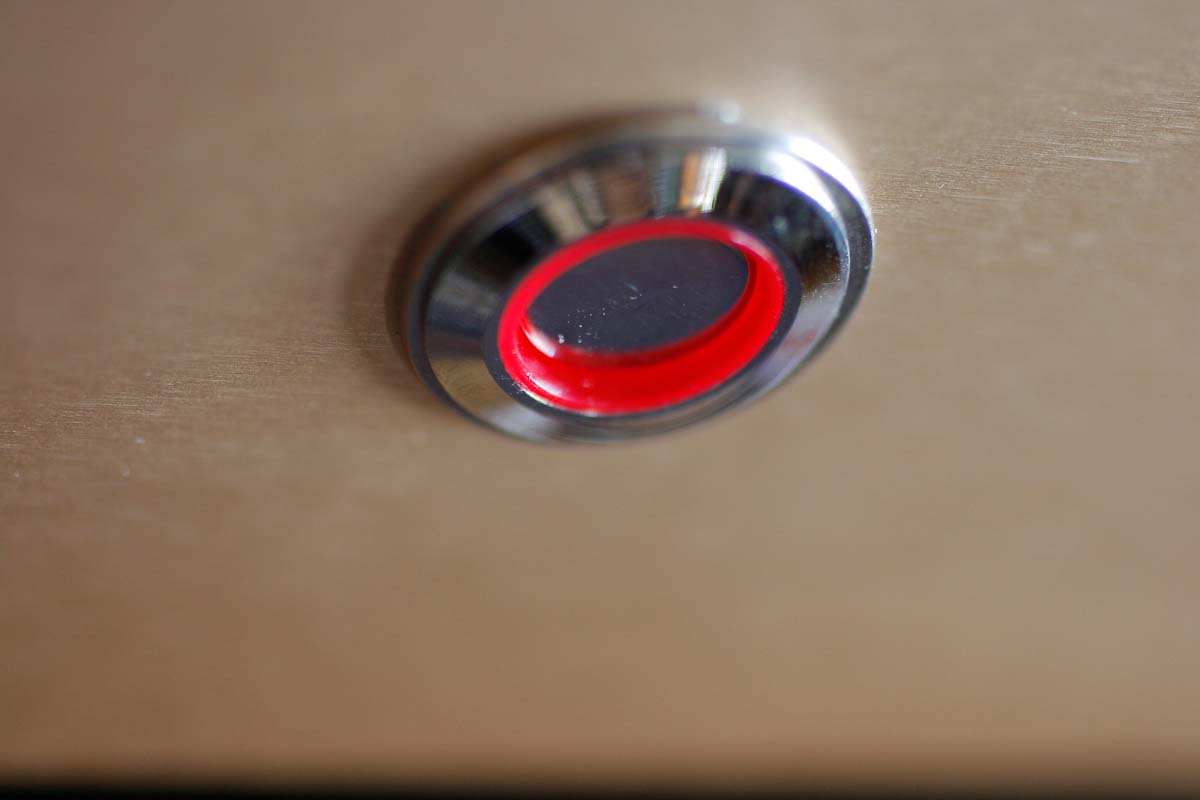
My new naval power switch with a ring led glow.
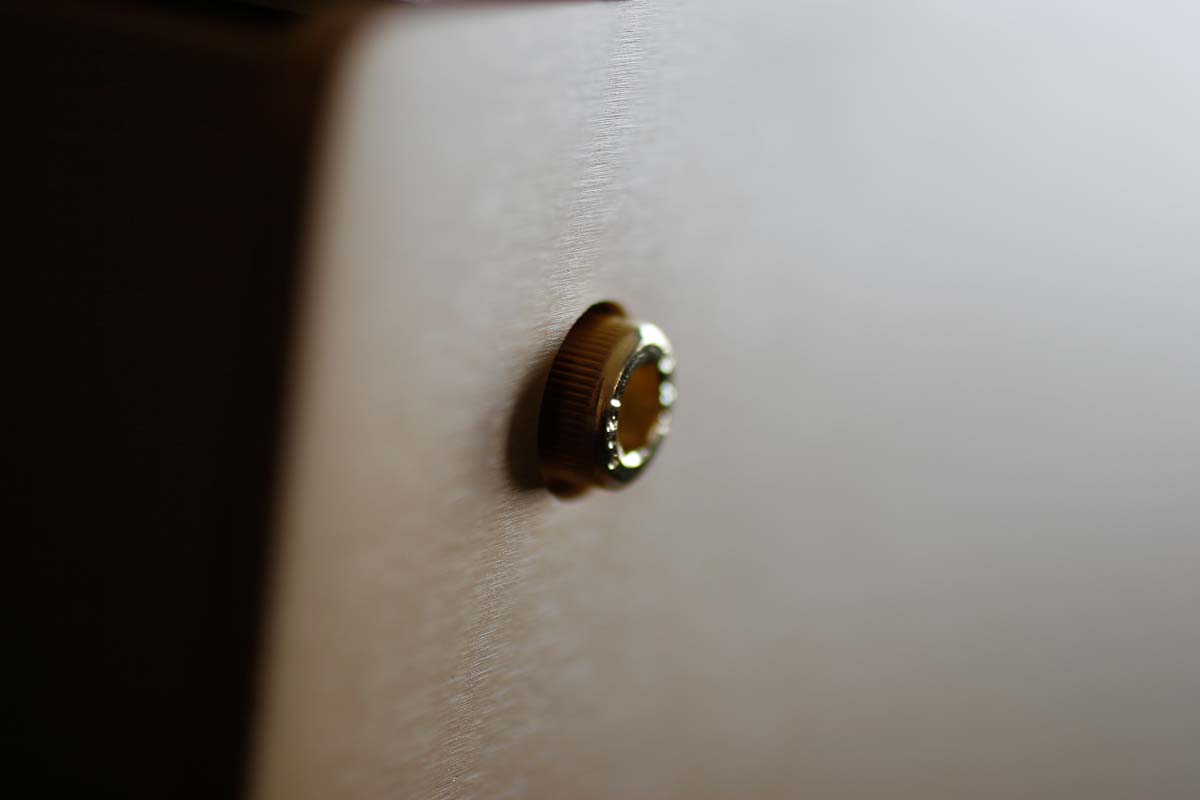
Detailing of the metalwork
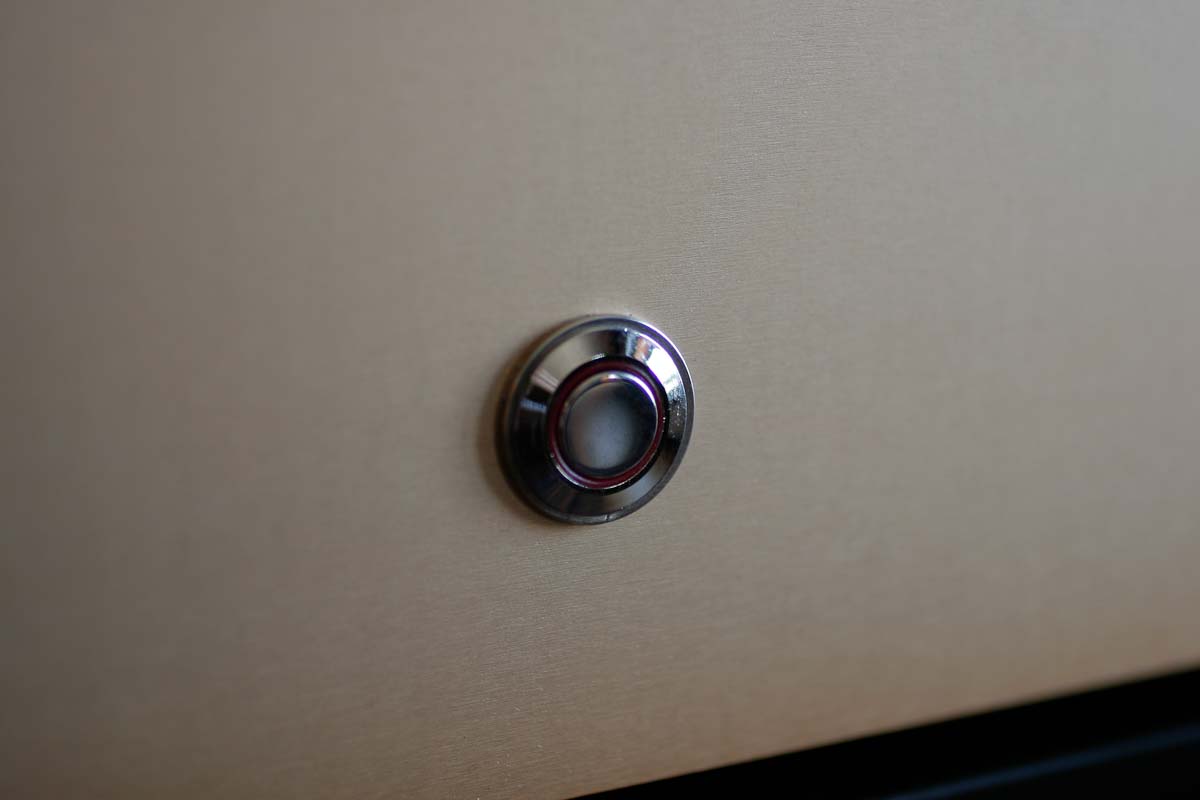
Th switch again
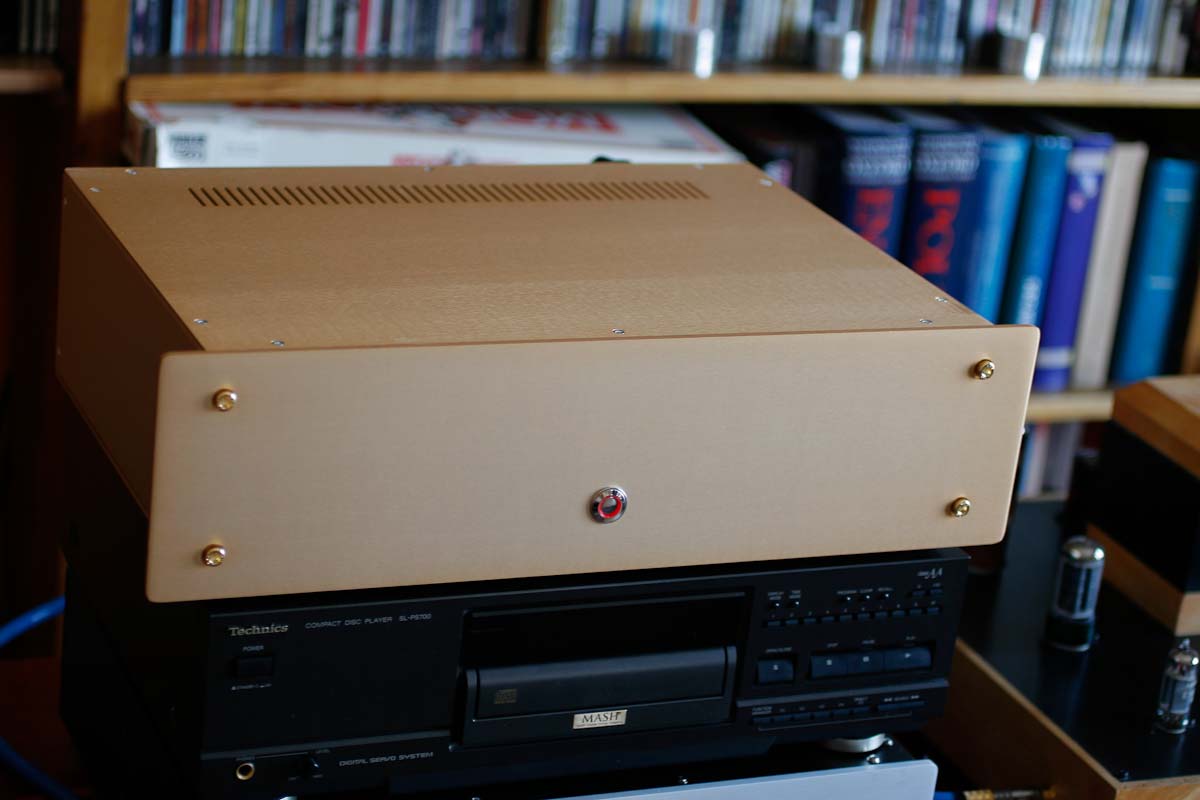
The whole huge box - I mean it is really BIG.

on the back side I designed two digital inputs and two parallel
outputs. There is also a fuse and AC inlet with a RFI filter.

Analog section general view.
The horizontal tube on the right is the rectification diode (octal type)

Above the detail of a hidden Behringer front panel.

This capacitor is so big - the internal volume is HALF LITER. I
used a same cap for Loredana's DAC with the Sabre chip.

To avoid any hum we used a thick 1,3 mm copper wire for the GND.

These Philips tubes are drop dead gorgeous (soundwise I mean, I am not
THAT crazy about tubes to call them gorgeous looking. Not that crazy) ,
beaten only by the siemens.
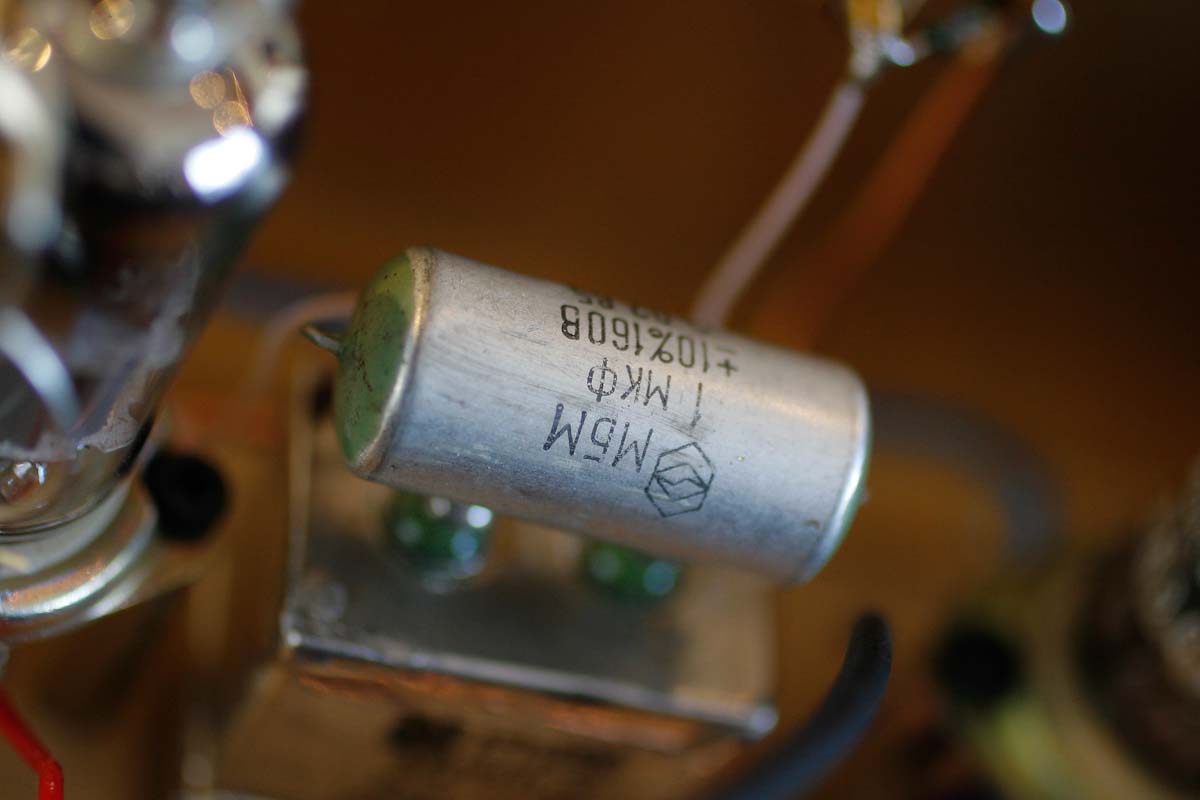
The famous soviet paper in oil - the MB means maslienno- bumaznyj. They
are 95 as good as PIO jensens.
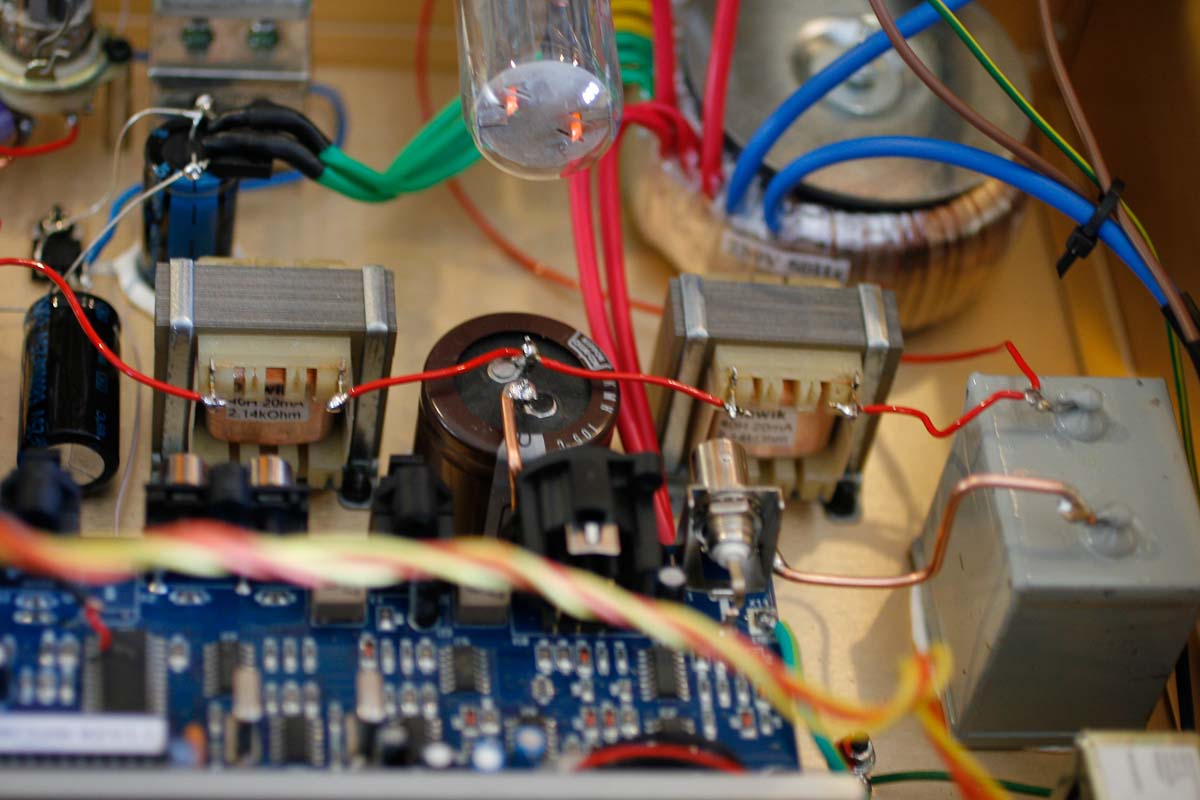
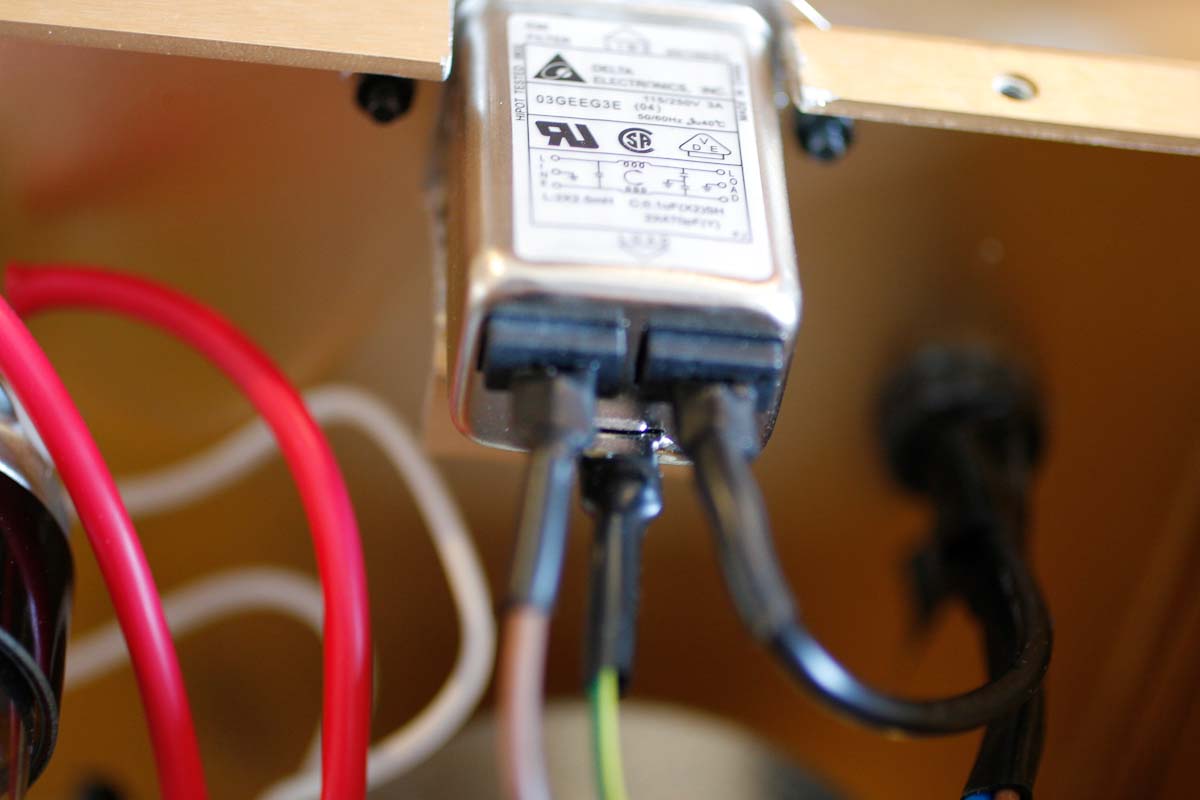
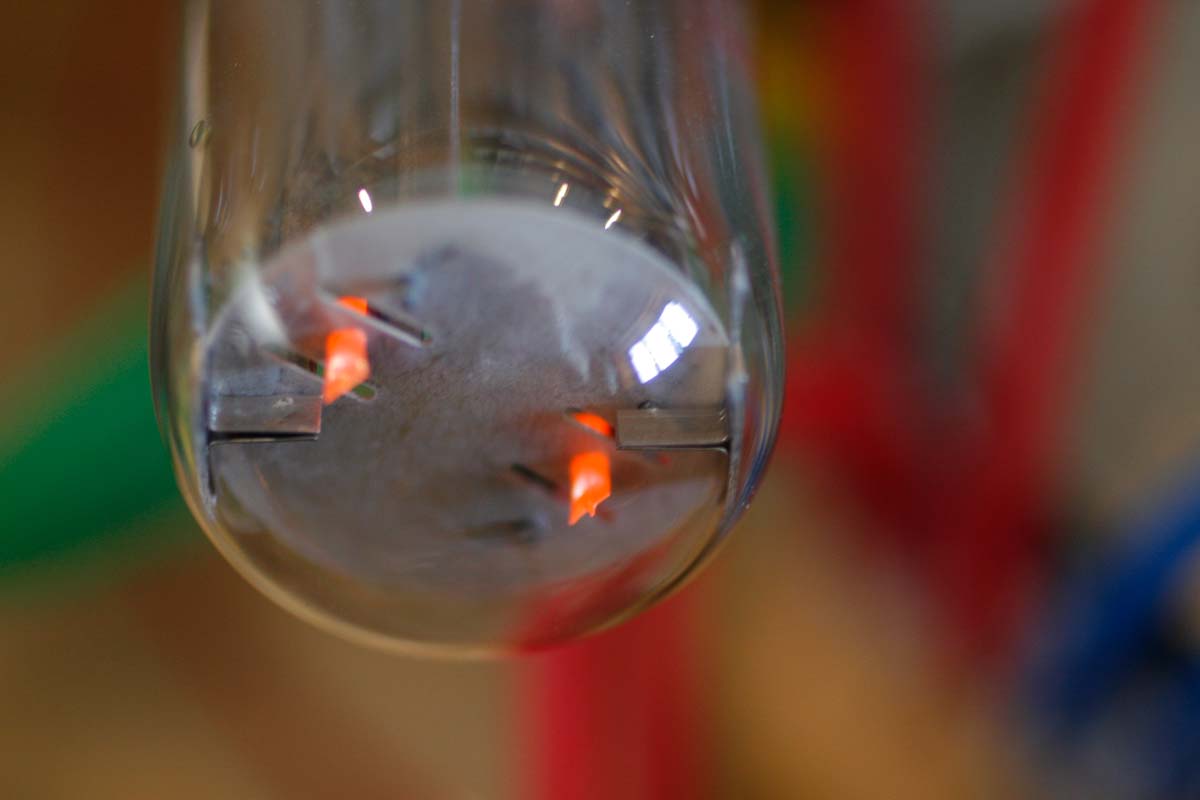
Nice glow of the dual diode
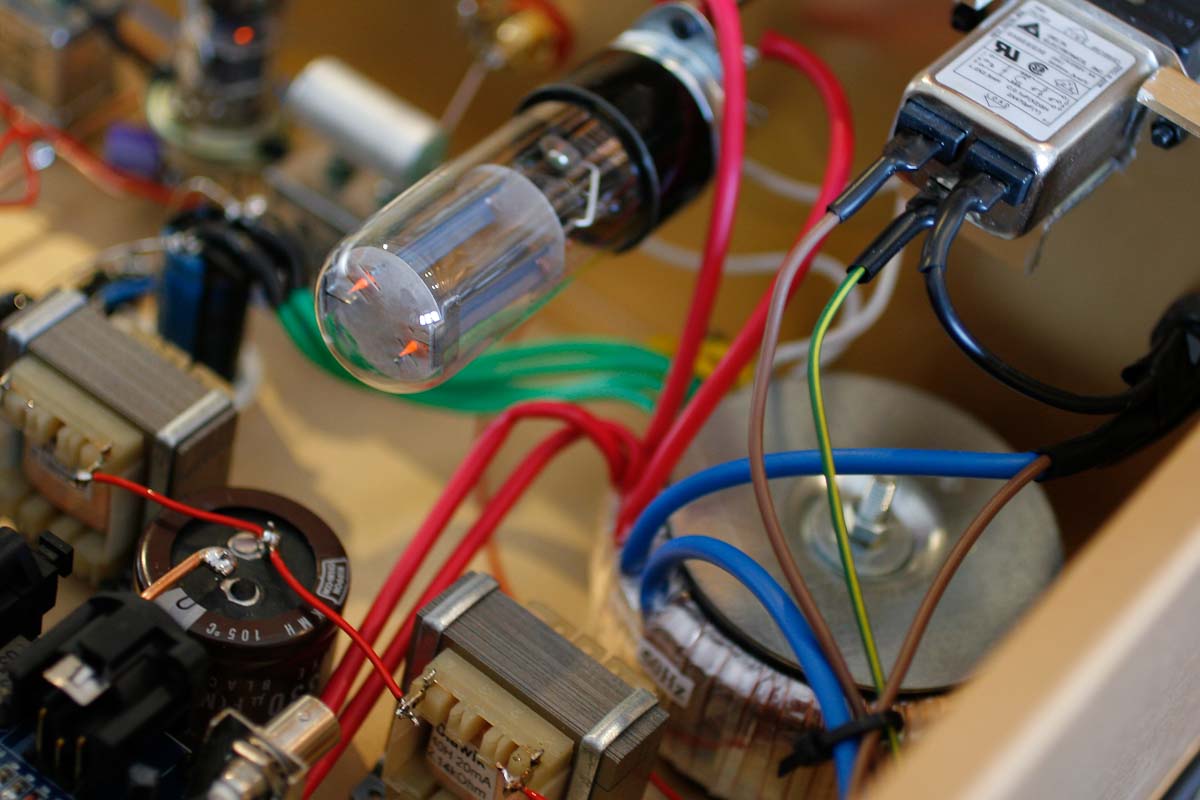
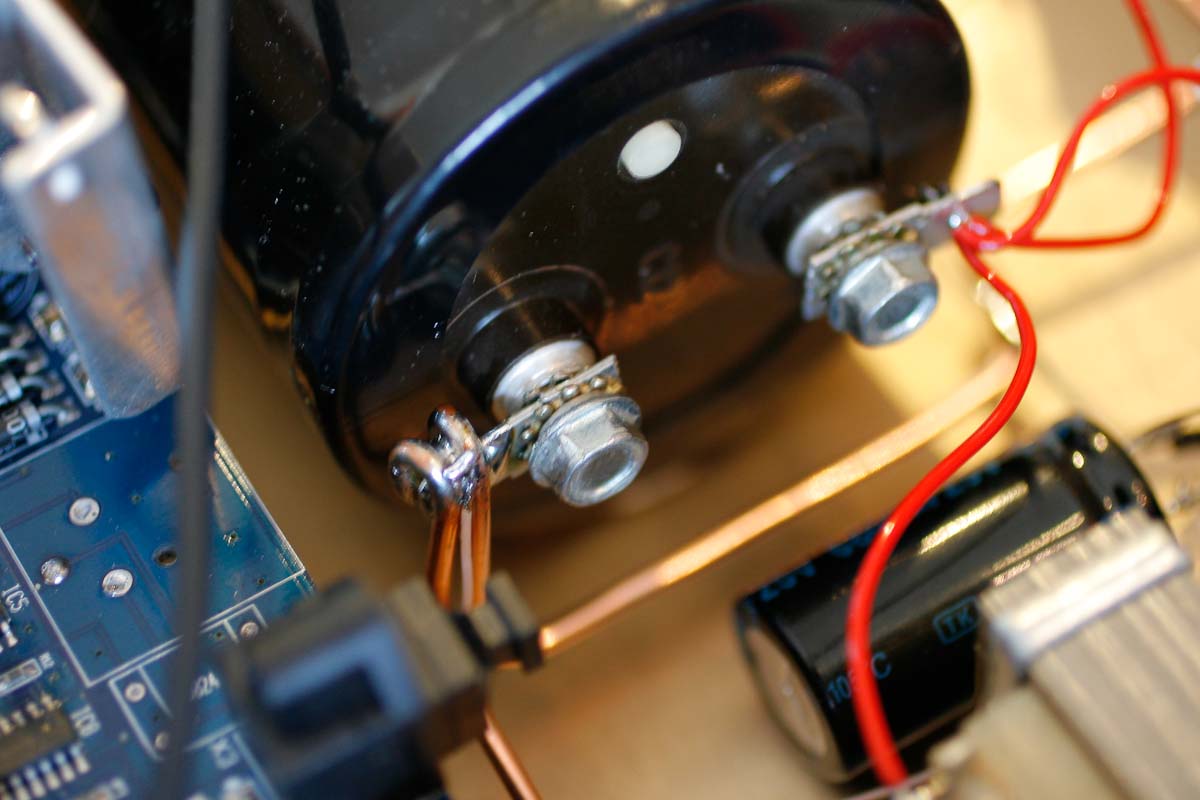
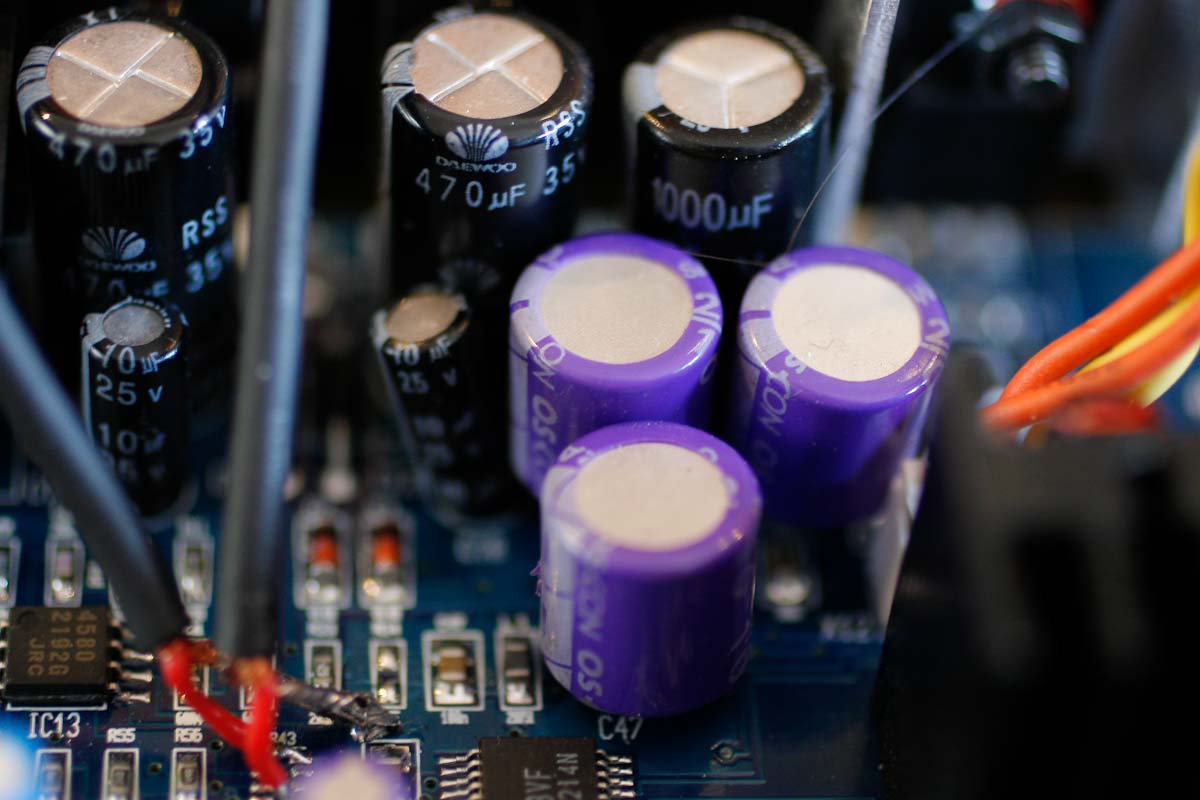
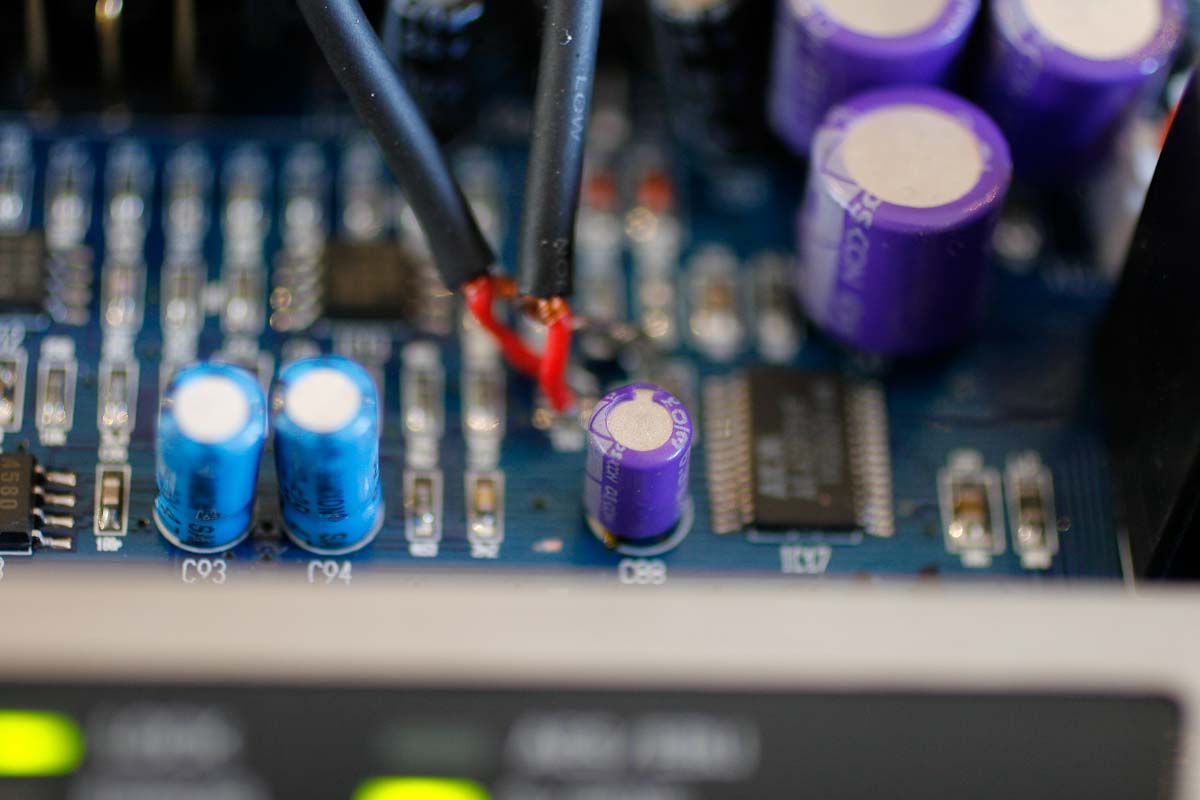
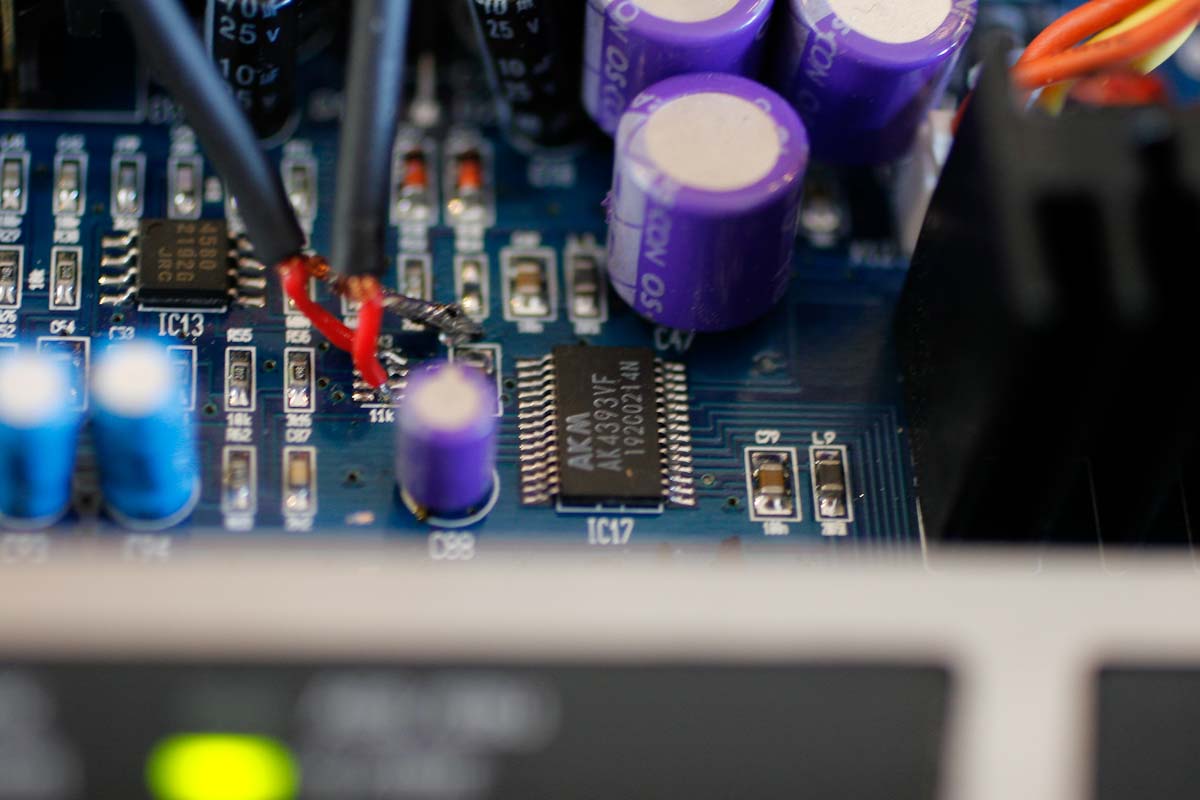
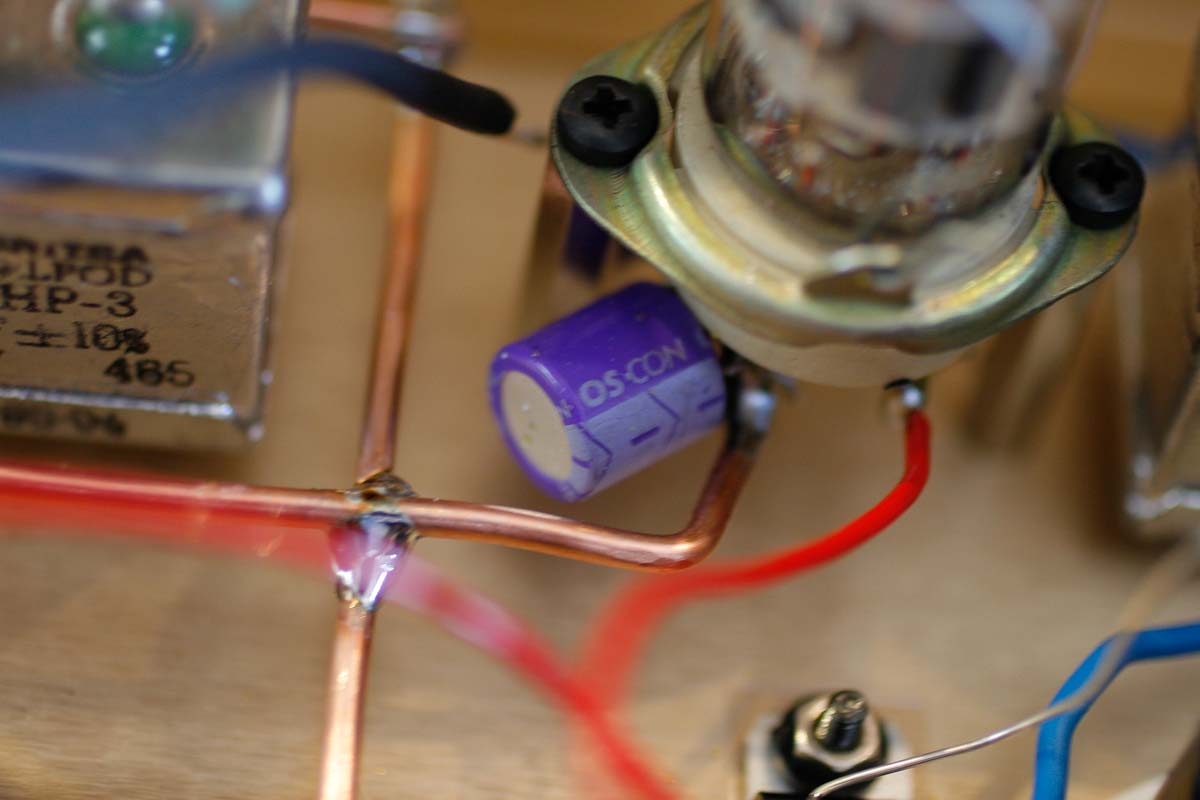
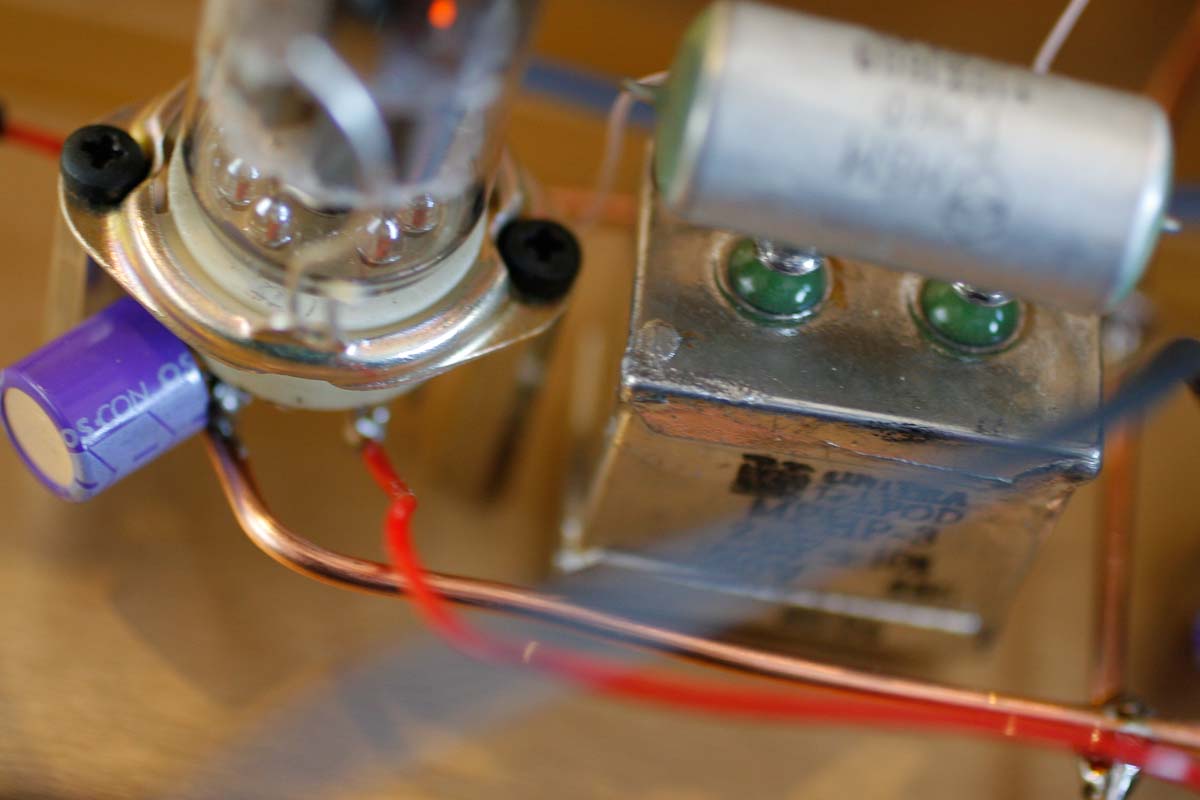

Isnt that switch cool ? It will become Lampizator's characteristic
unique selling proposition.
Now, the tricky part: will the new owner like it ????
a month later
(He did)













































